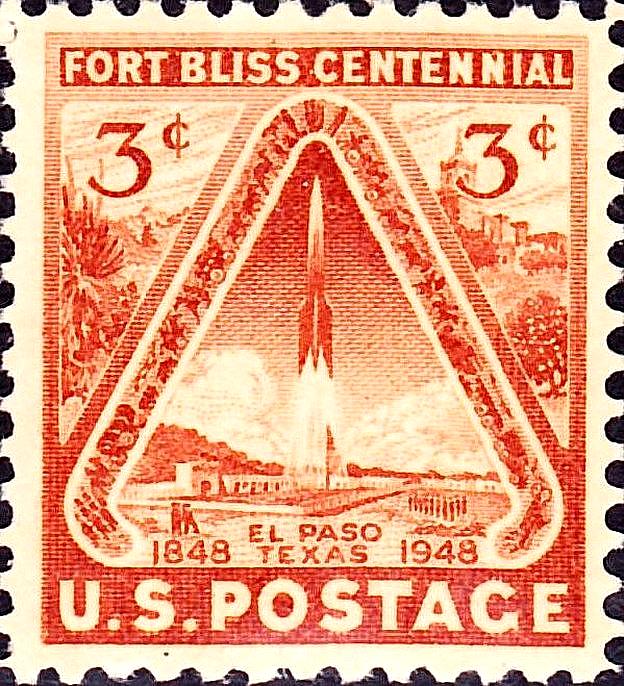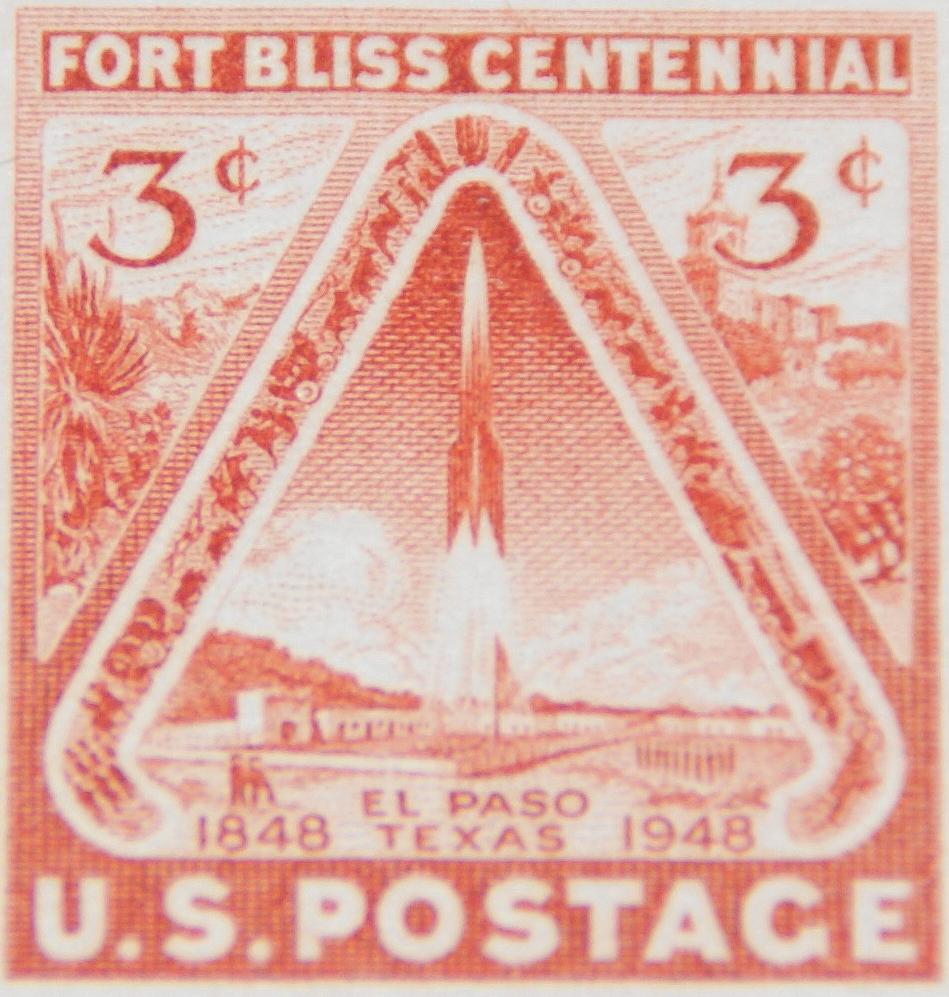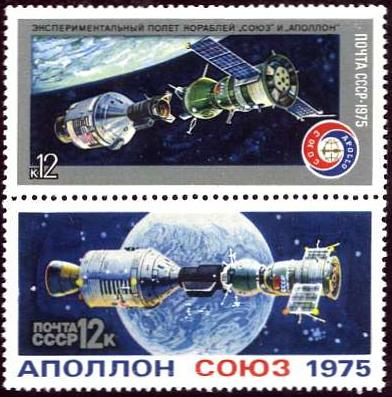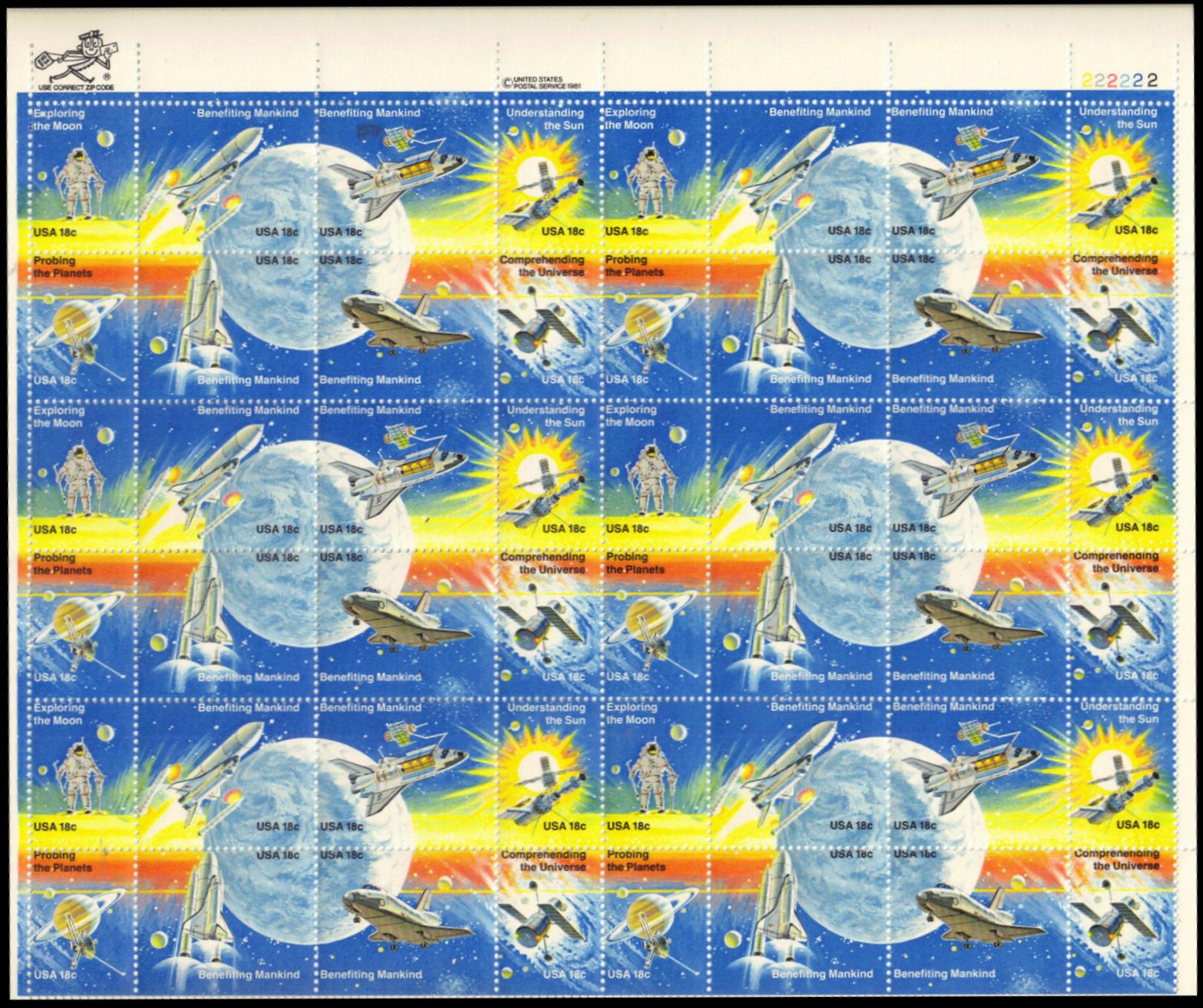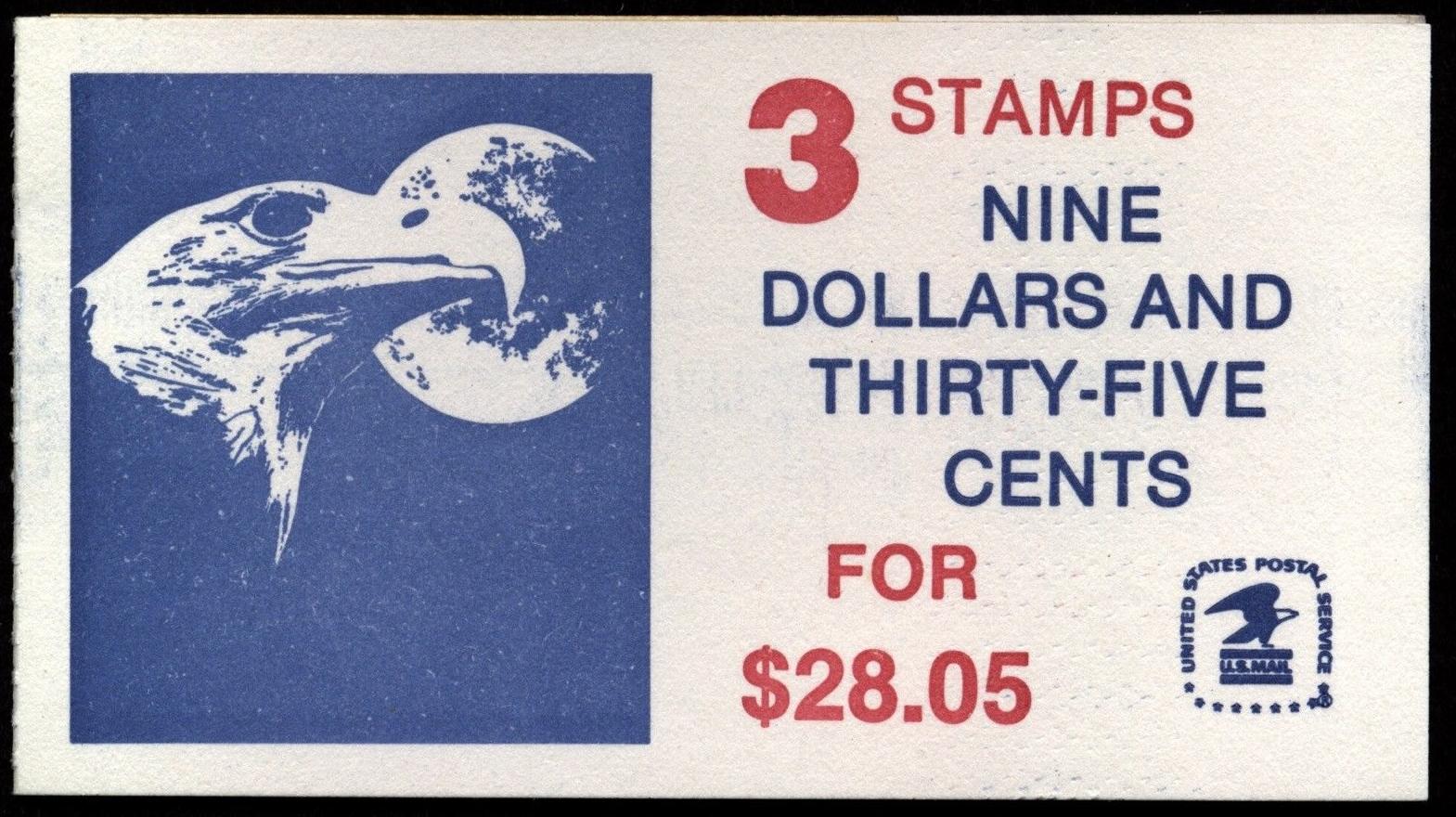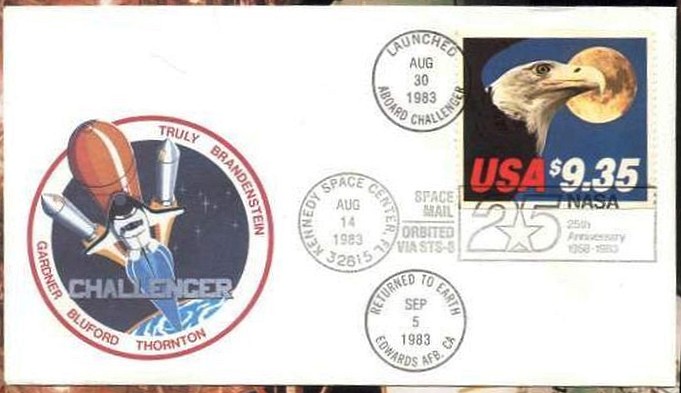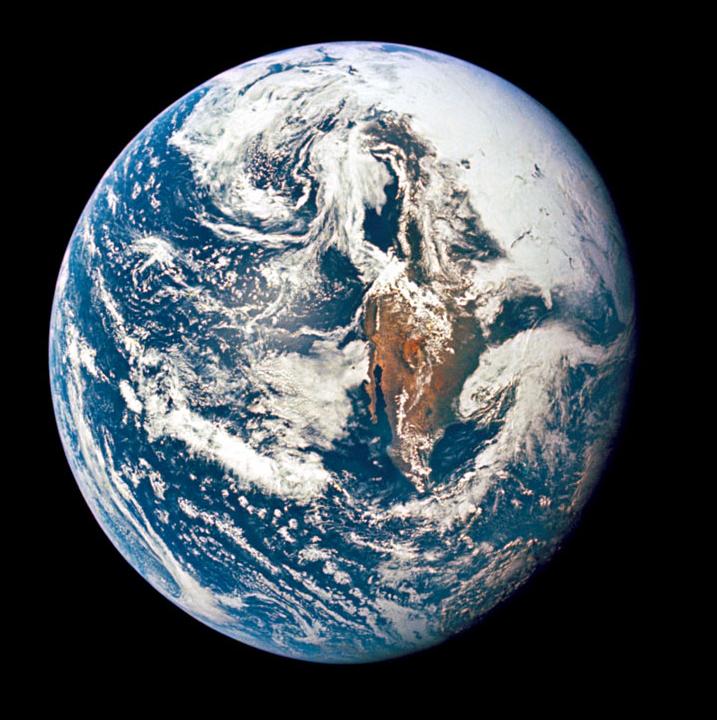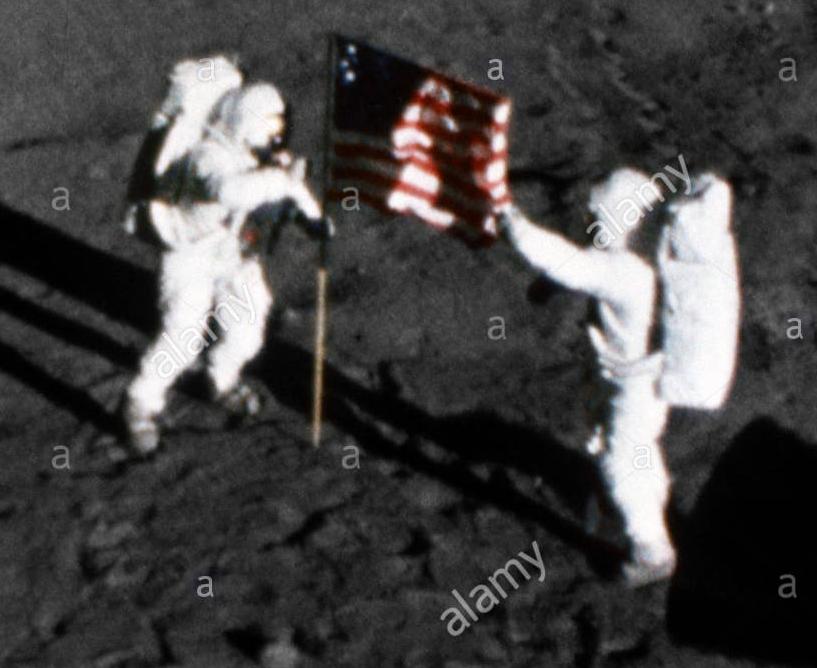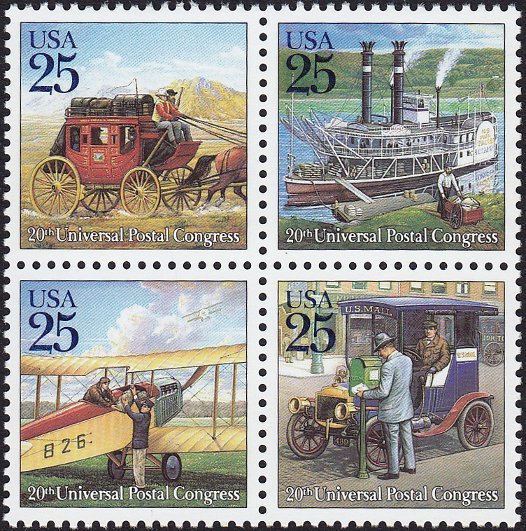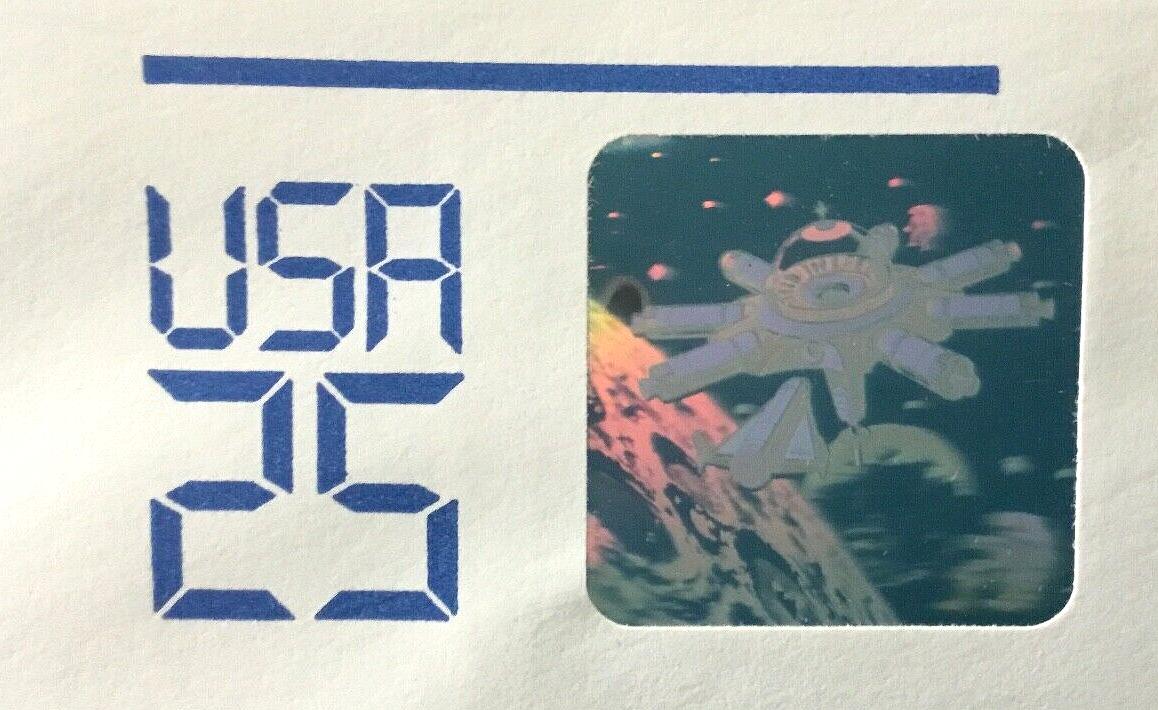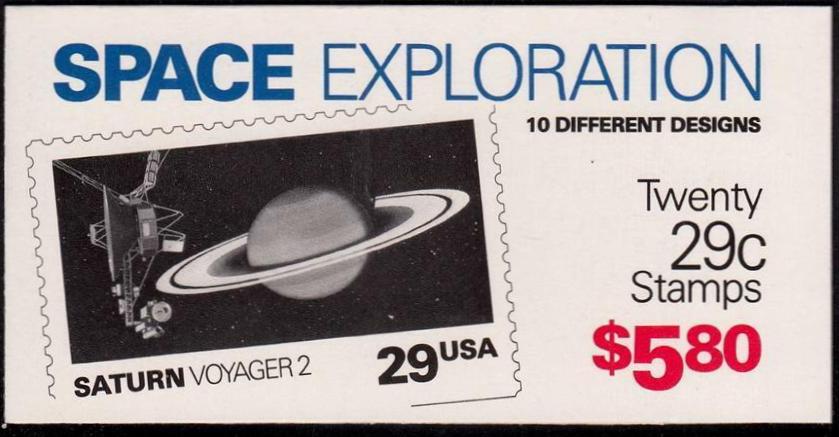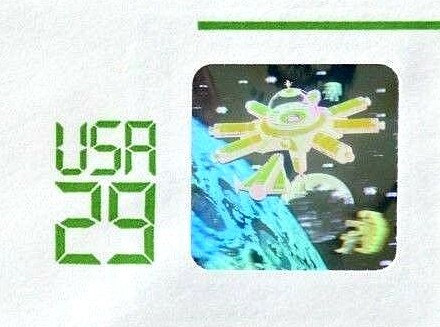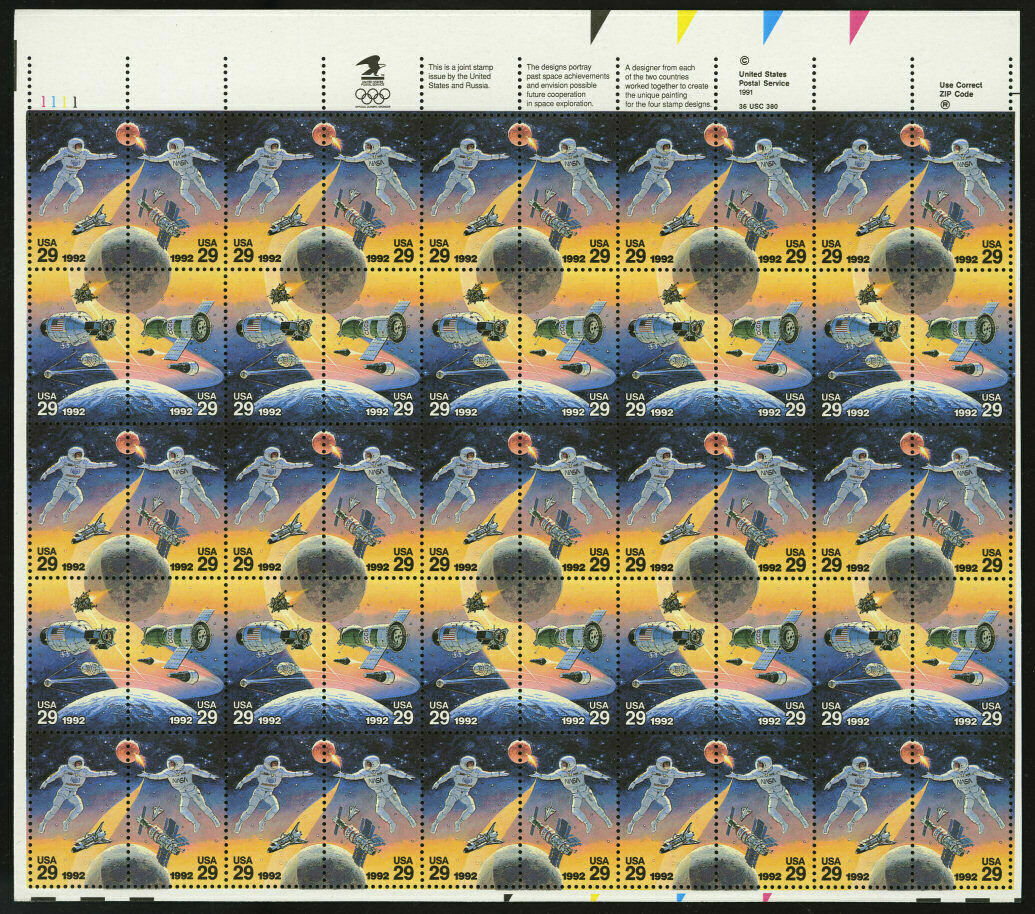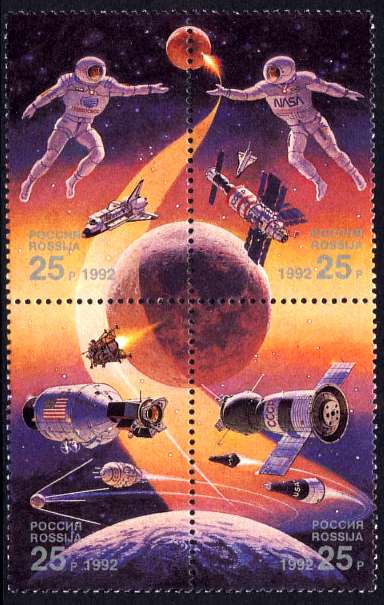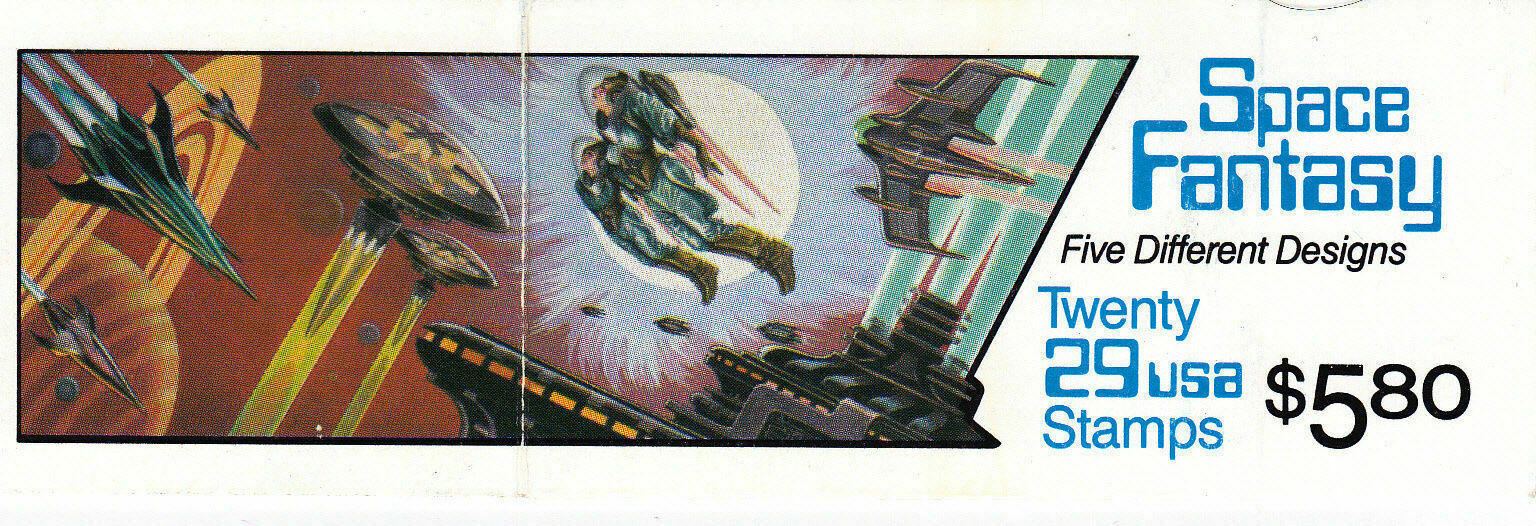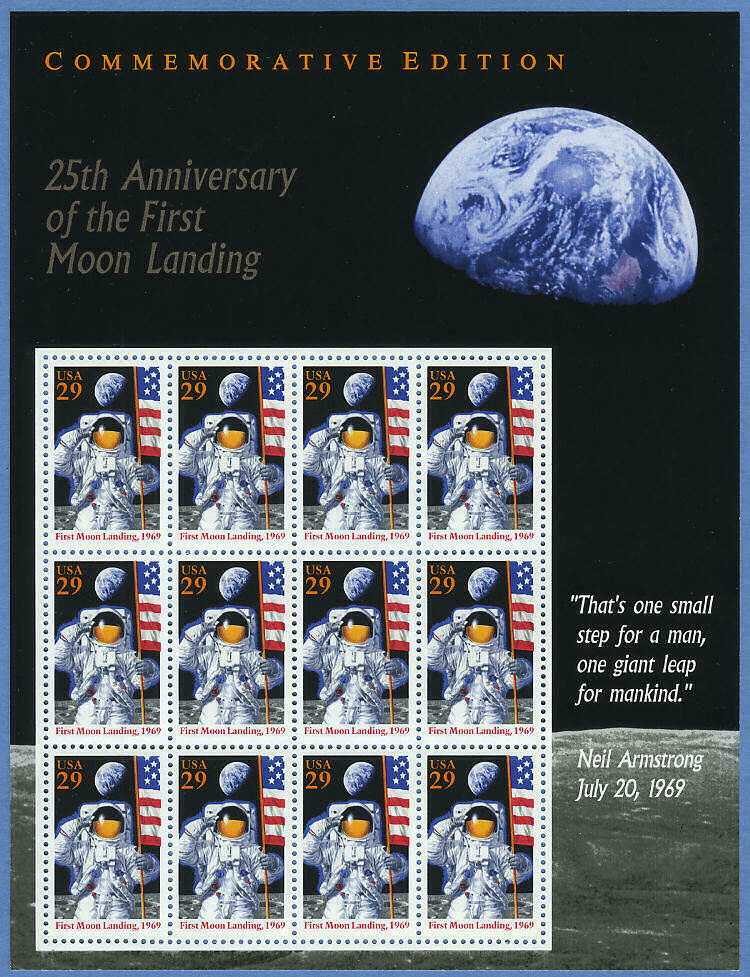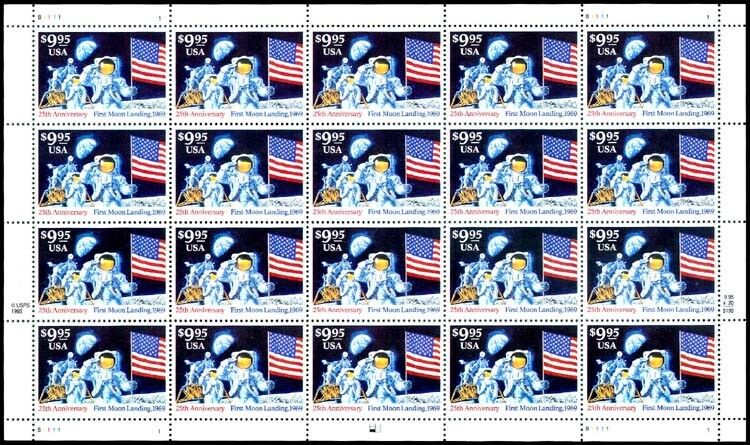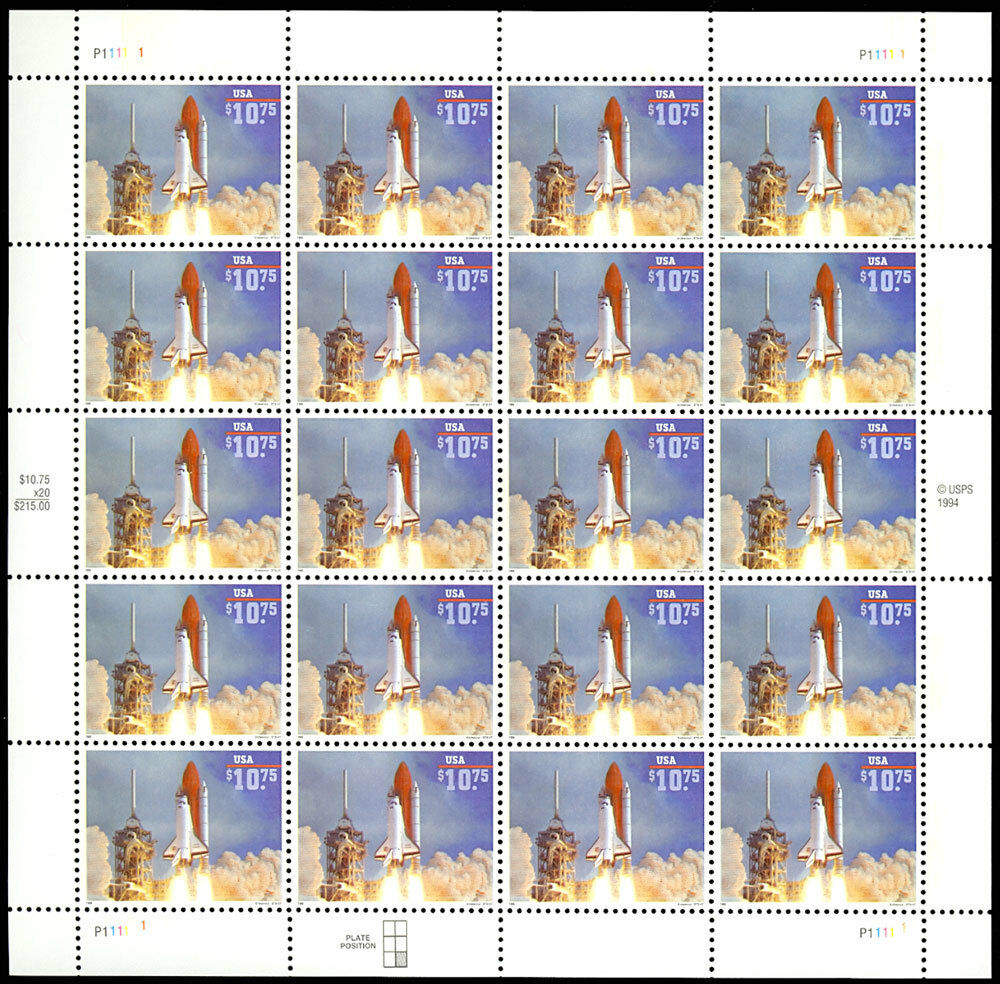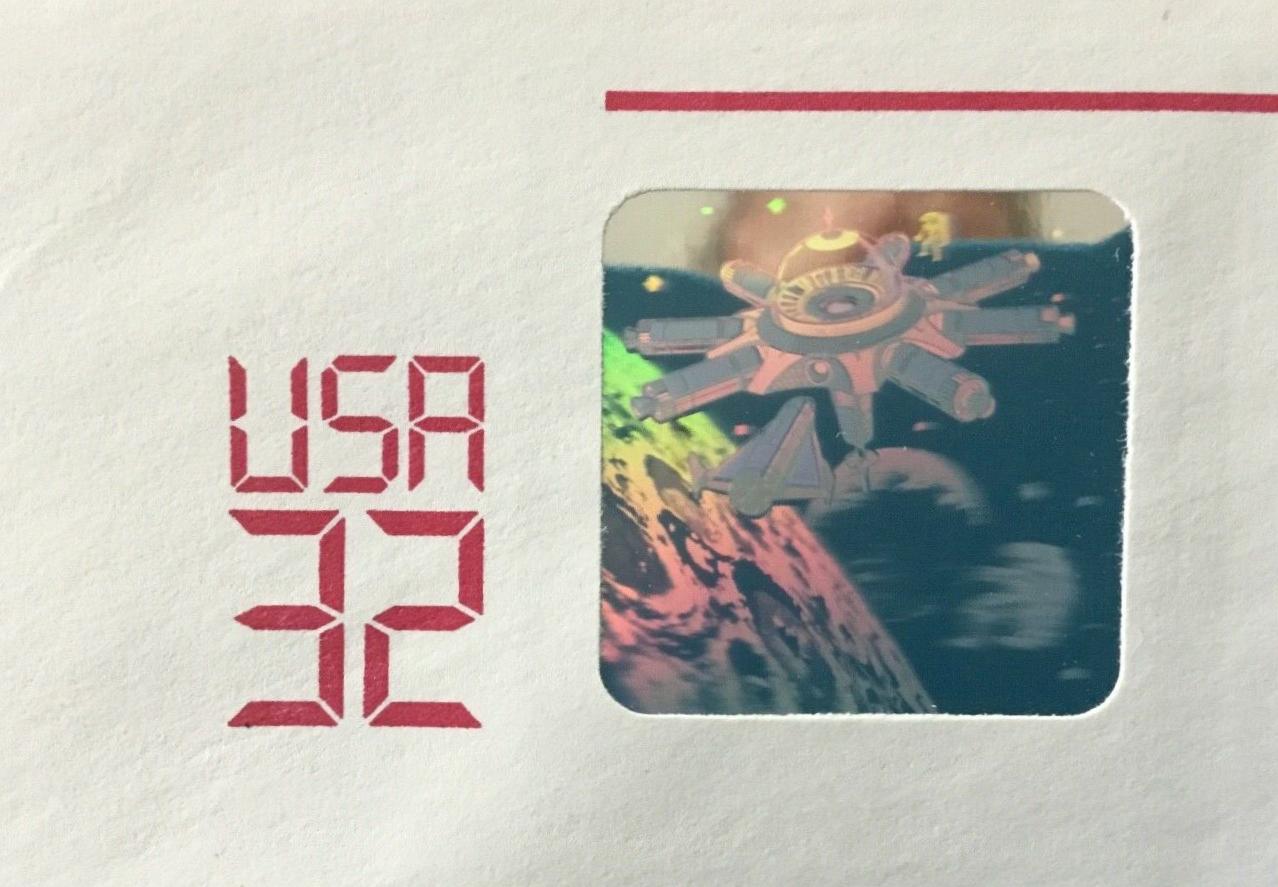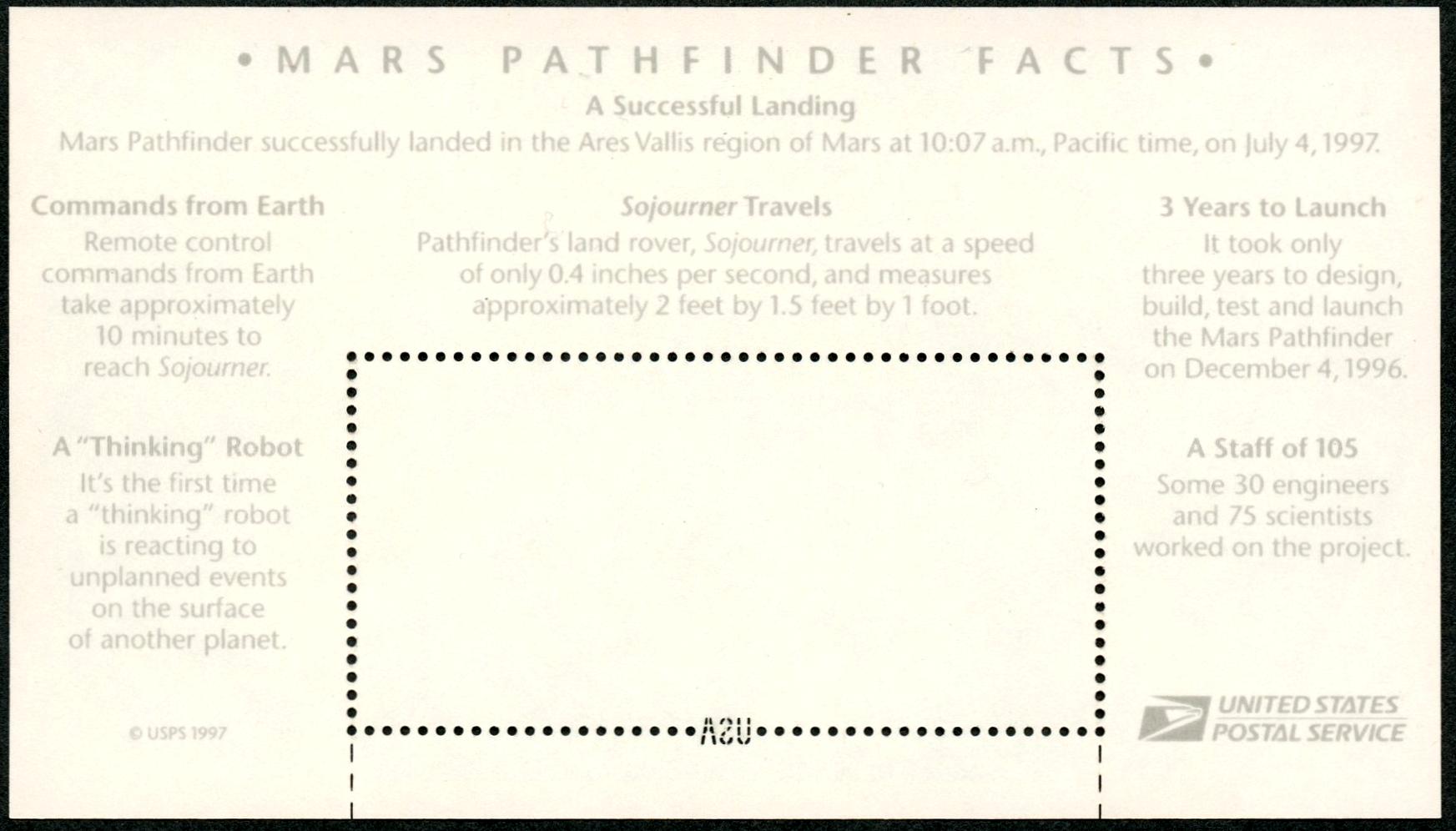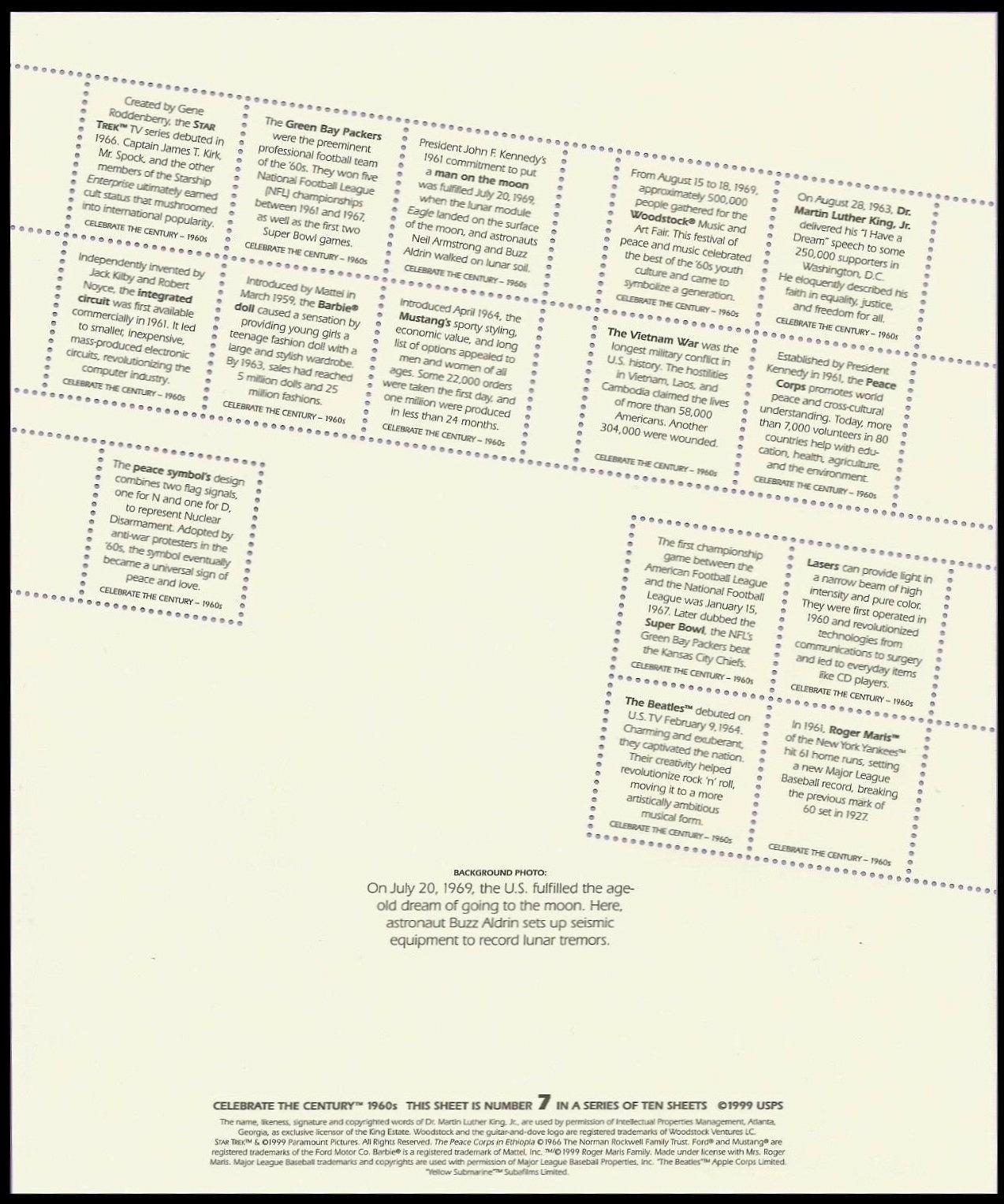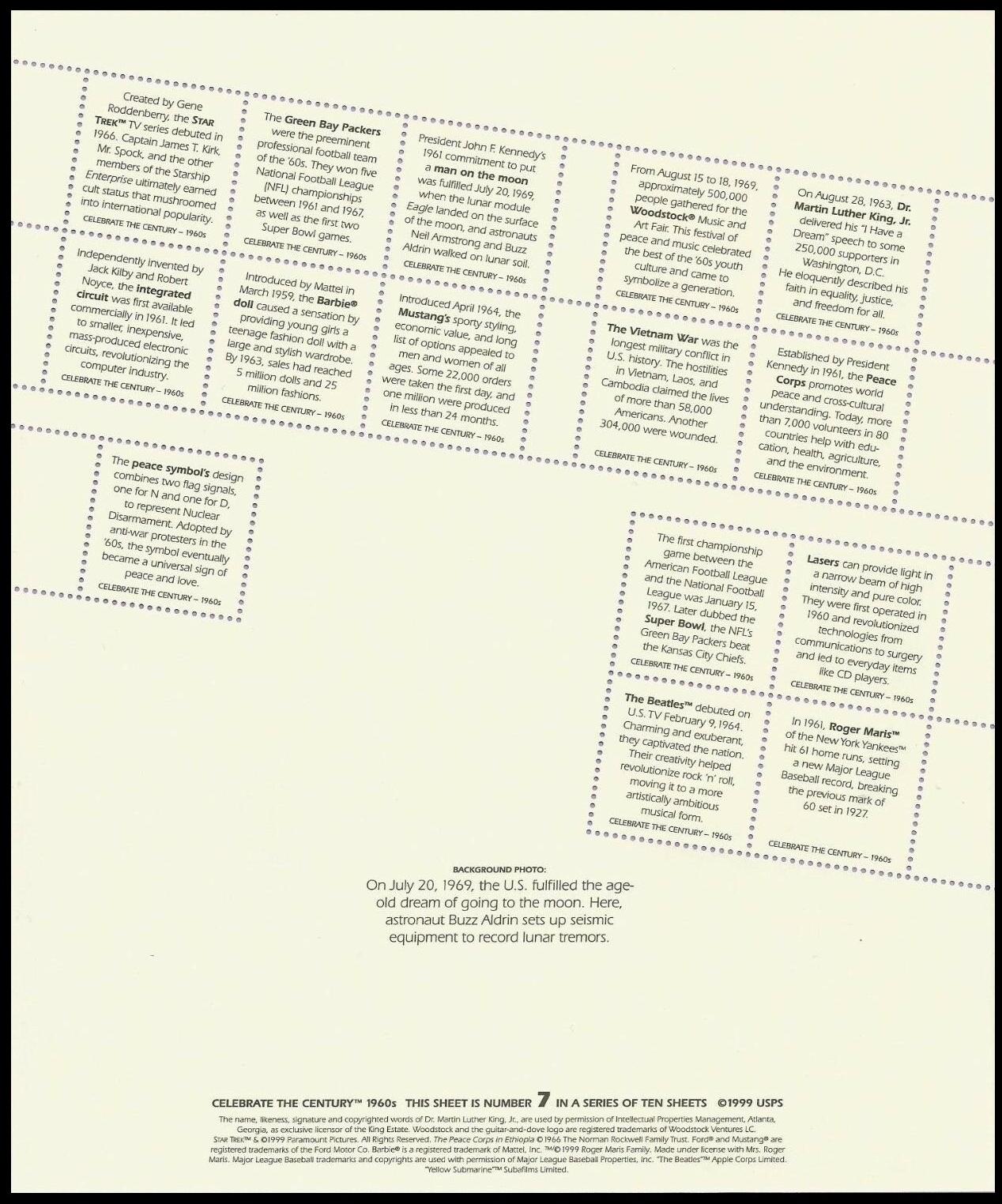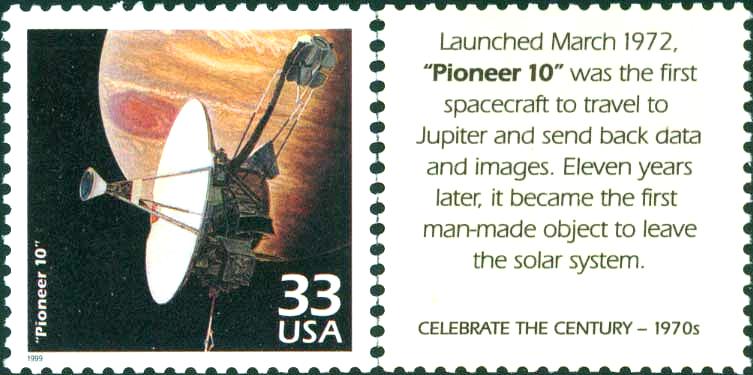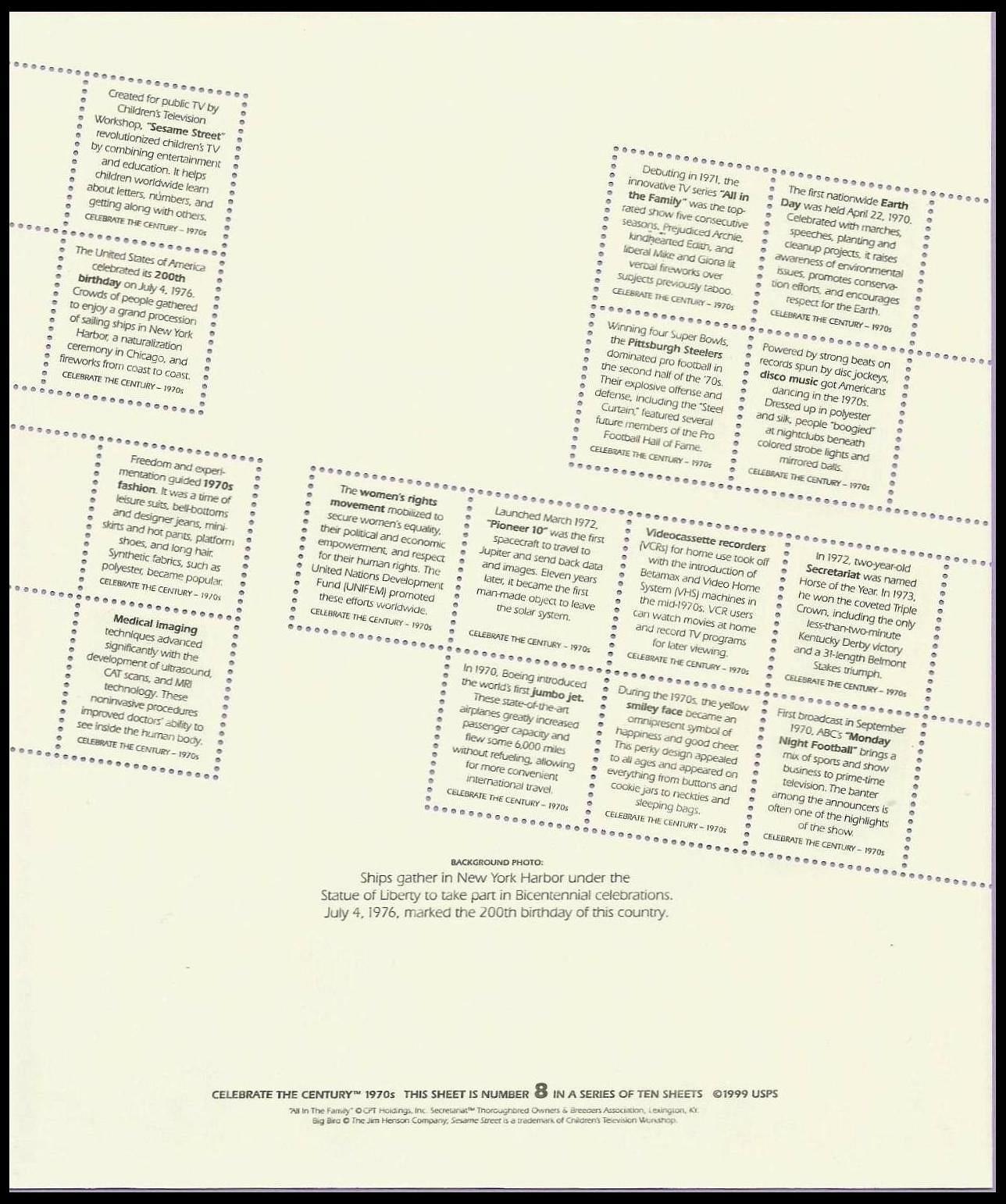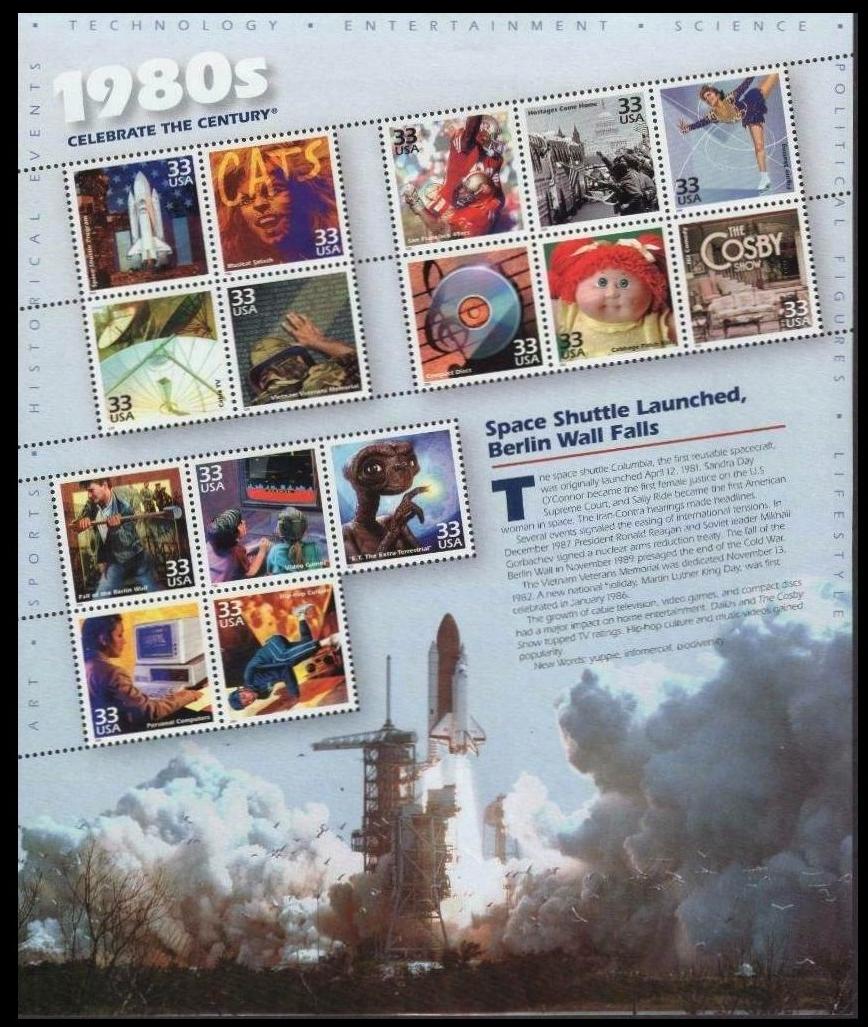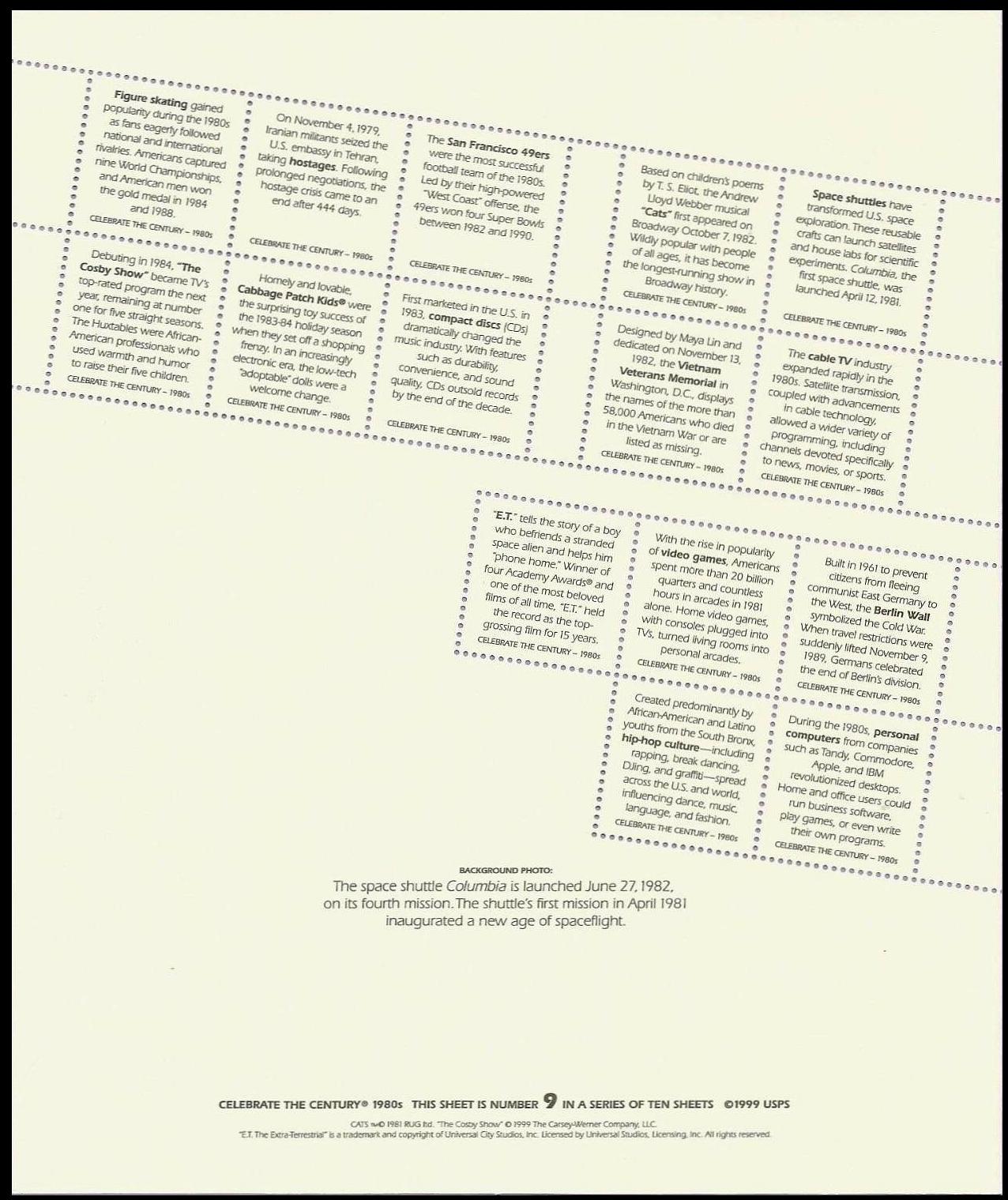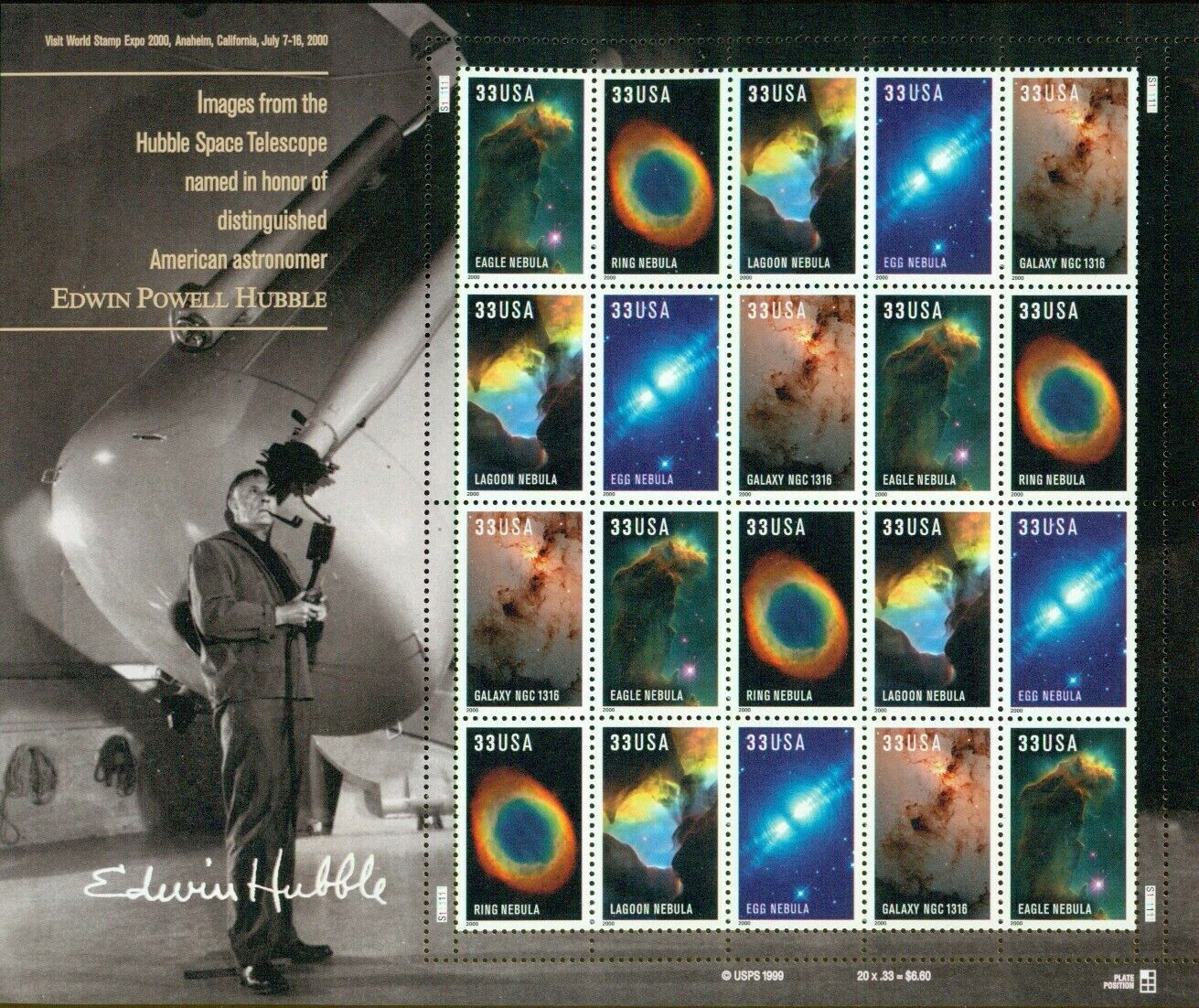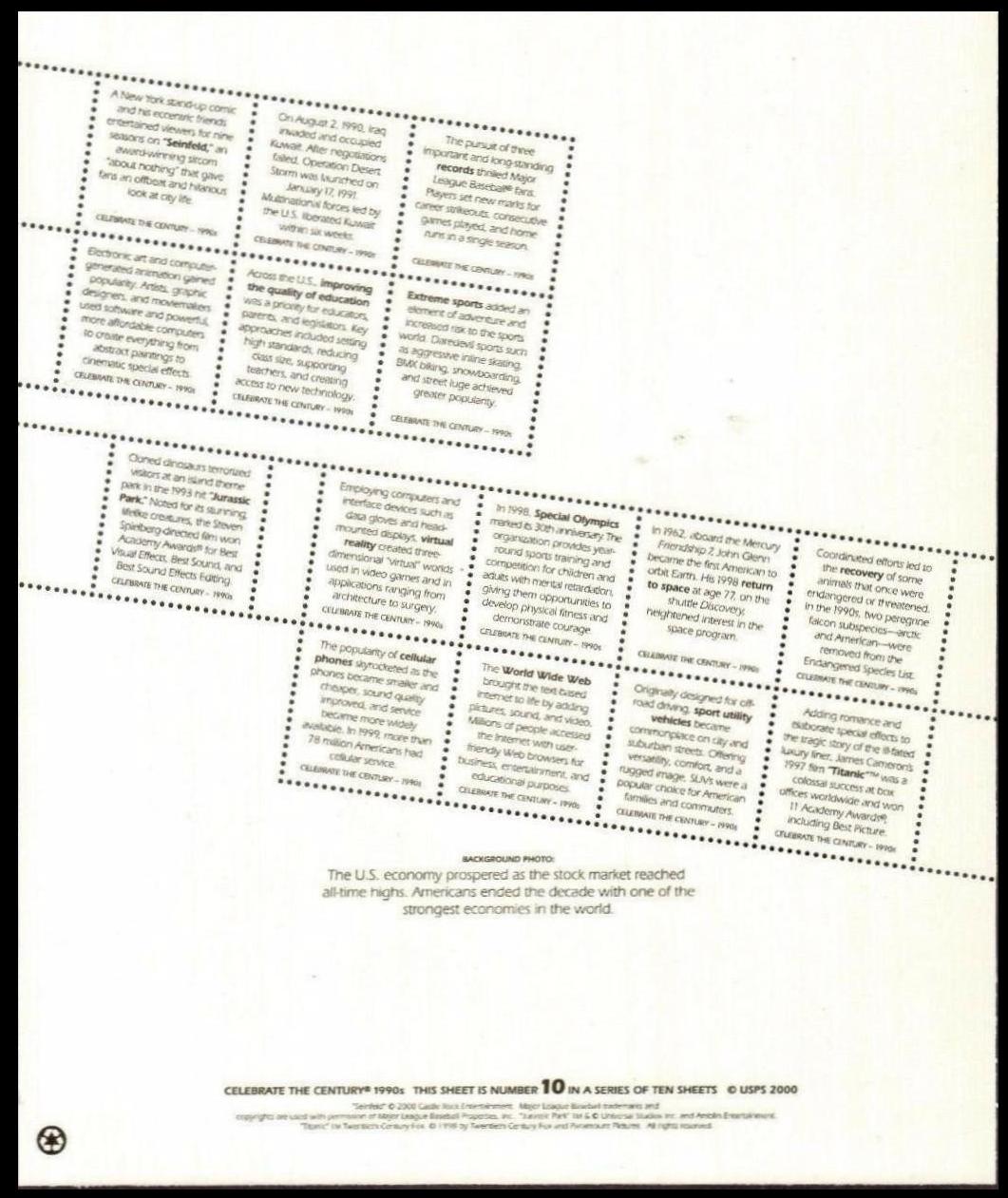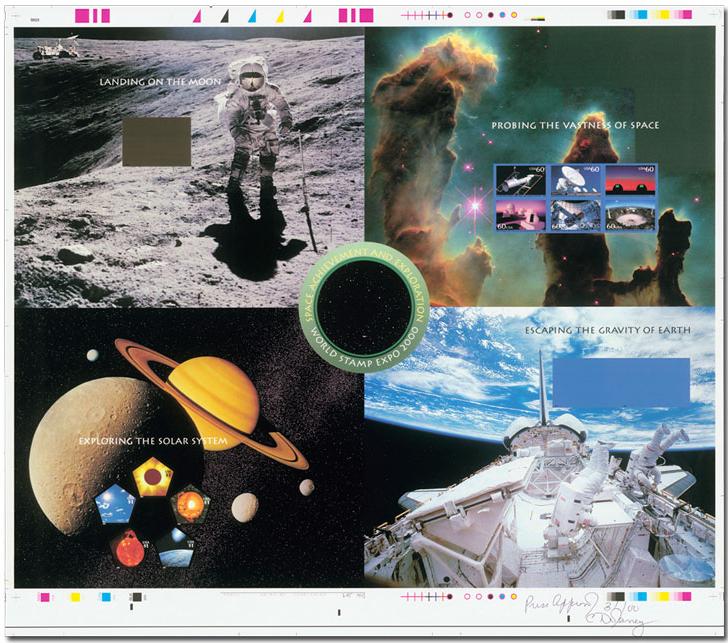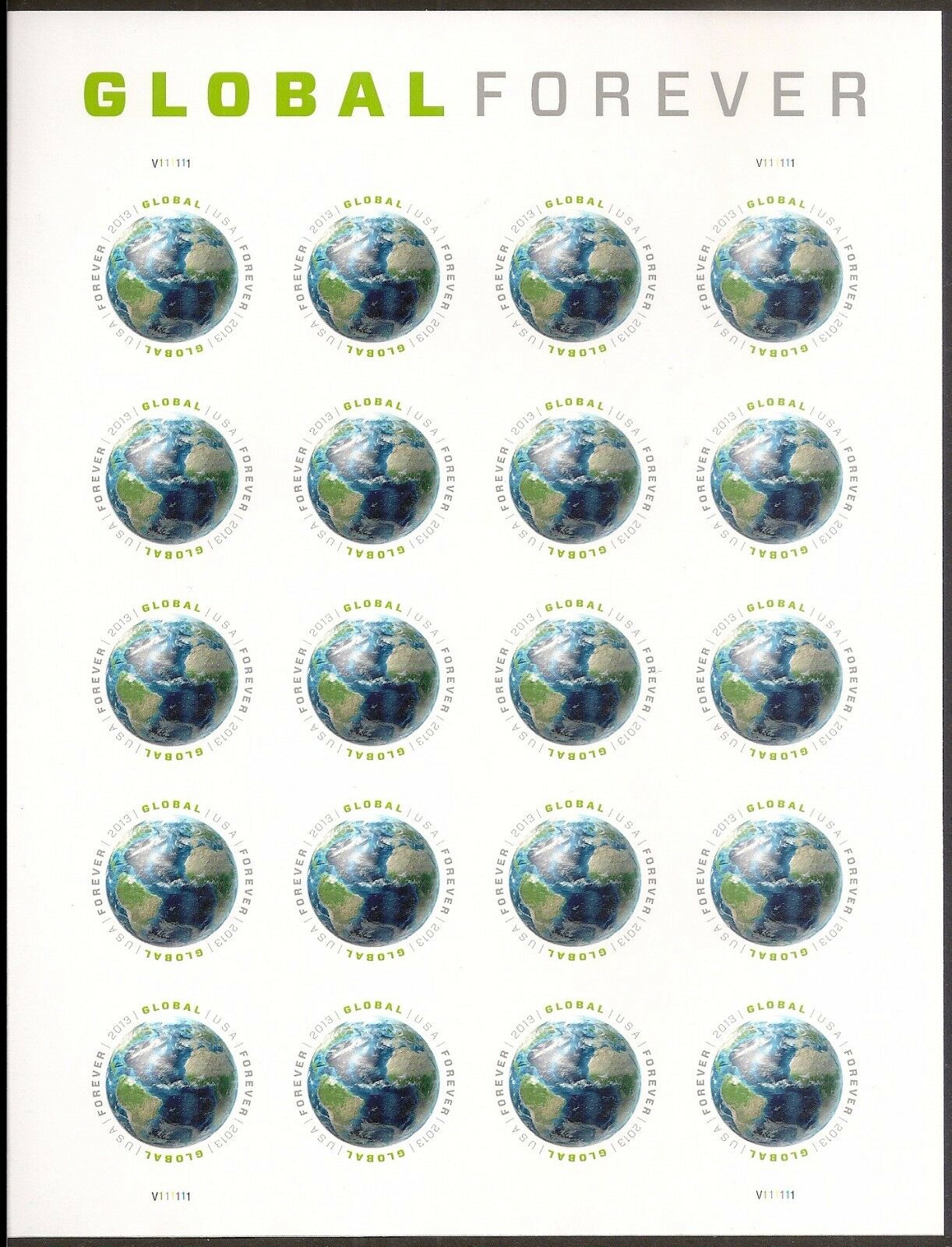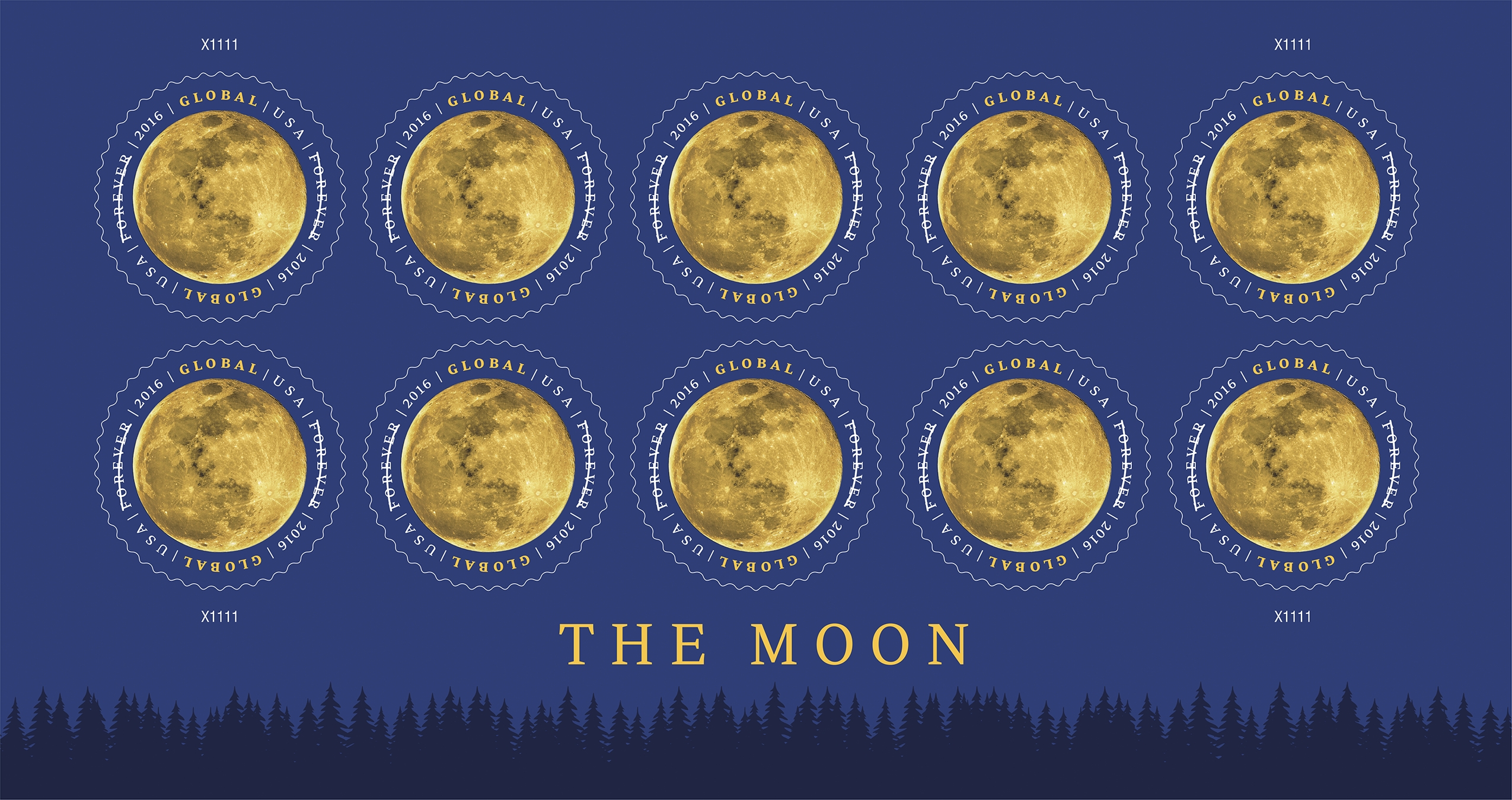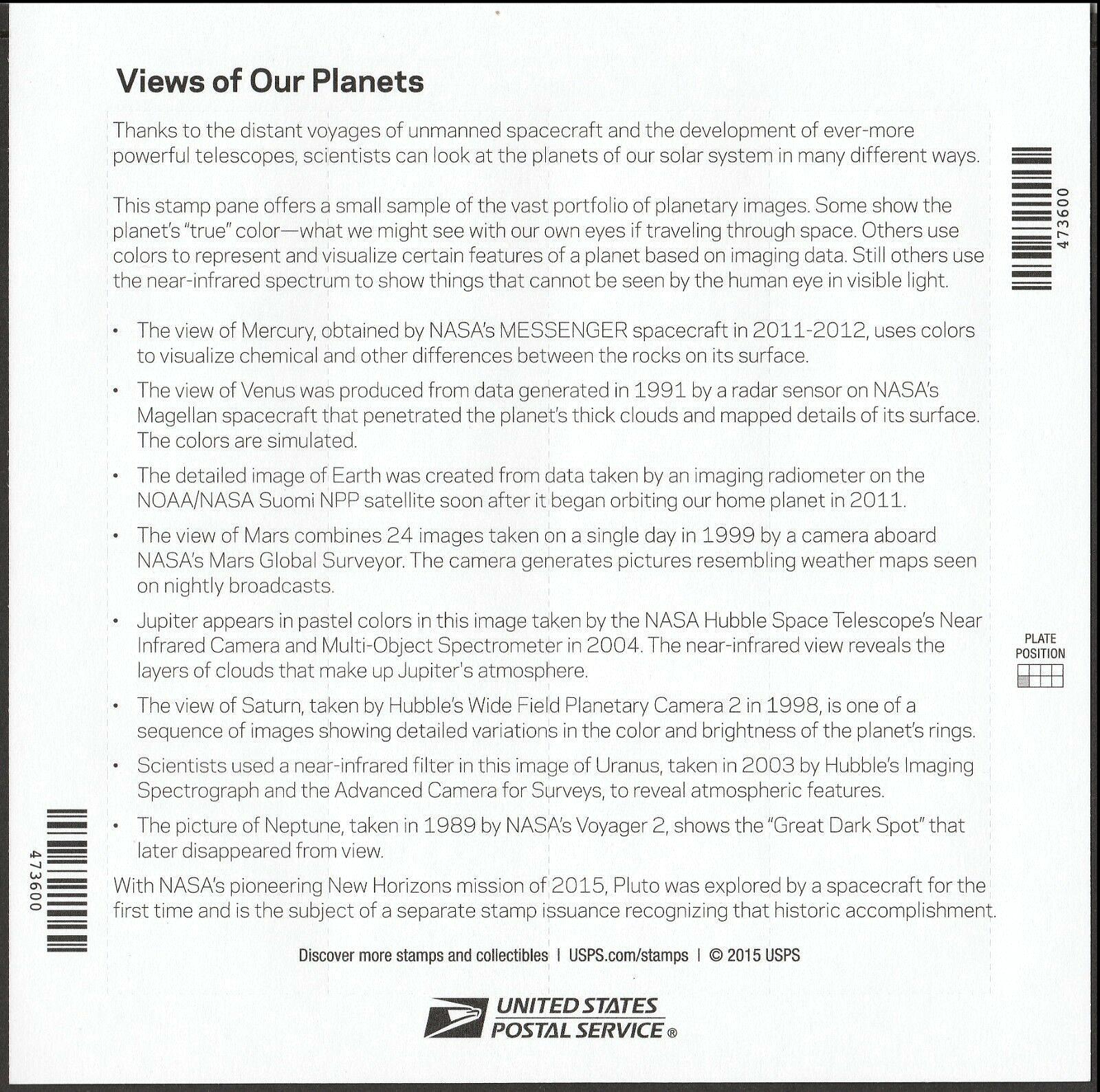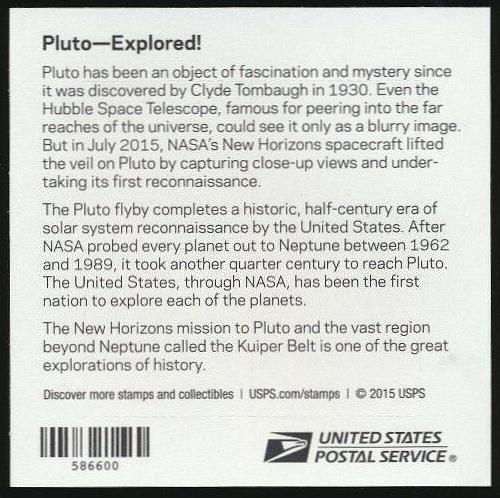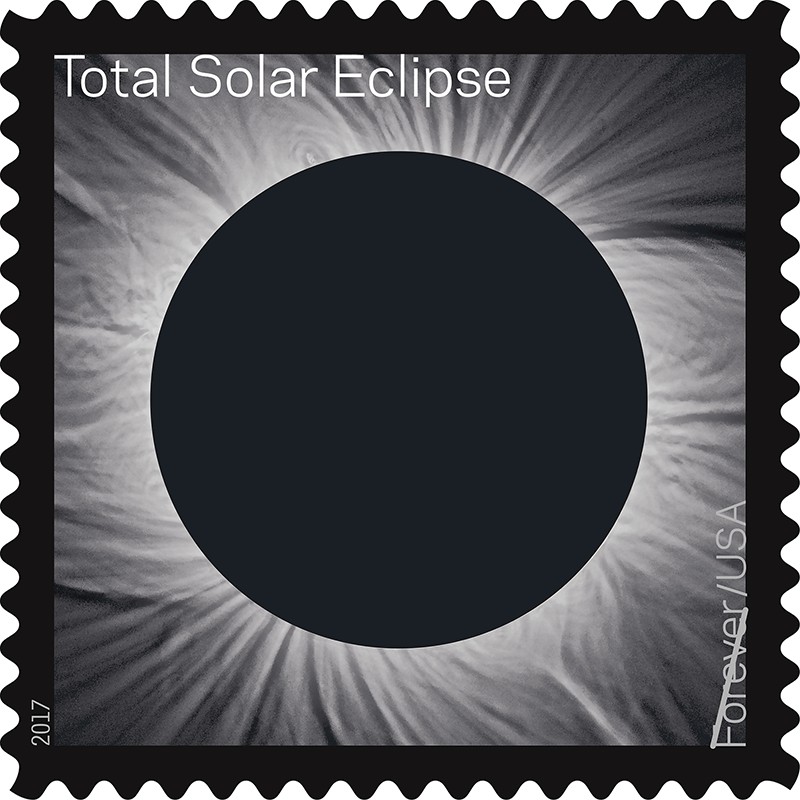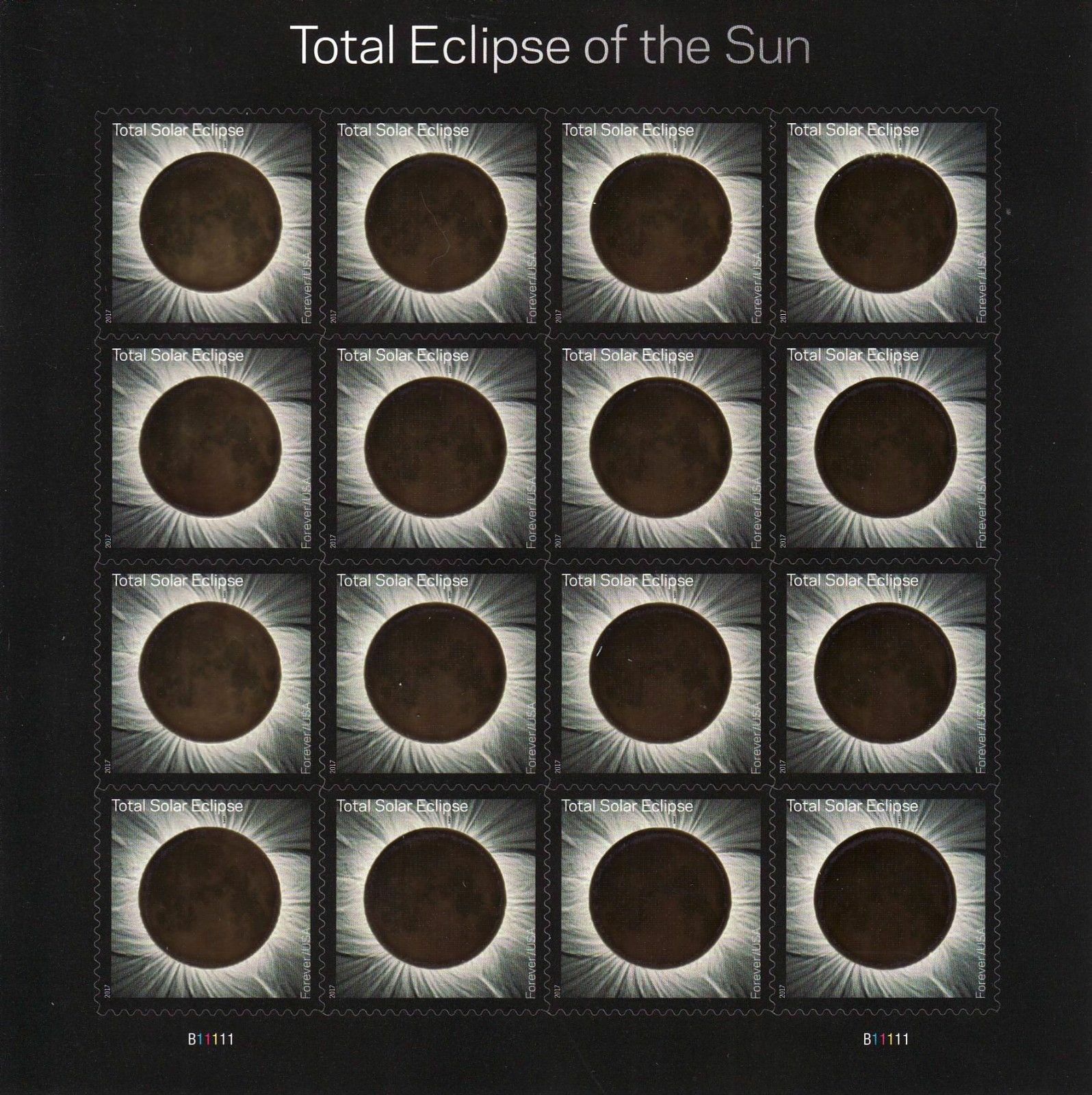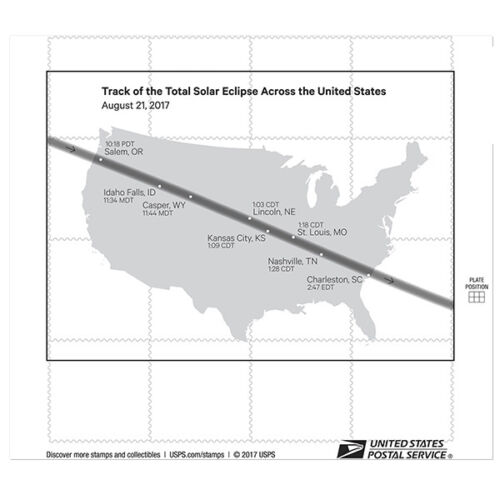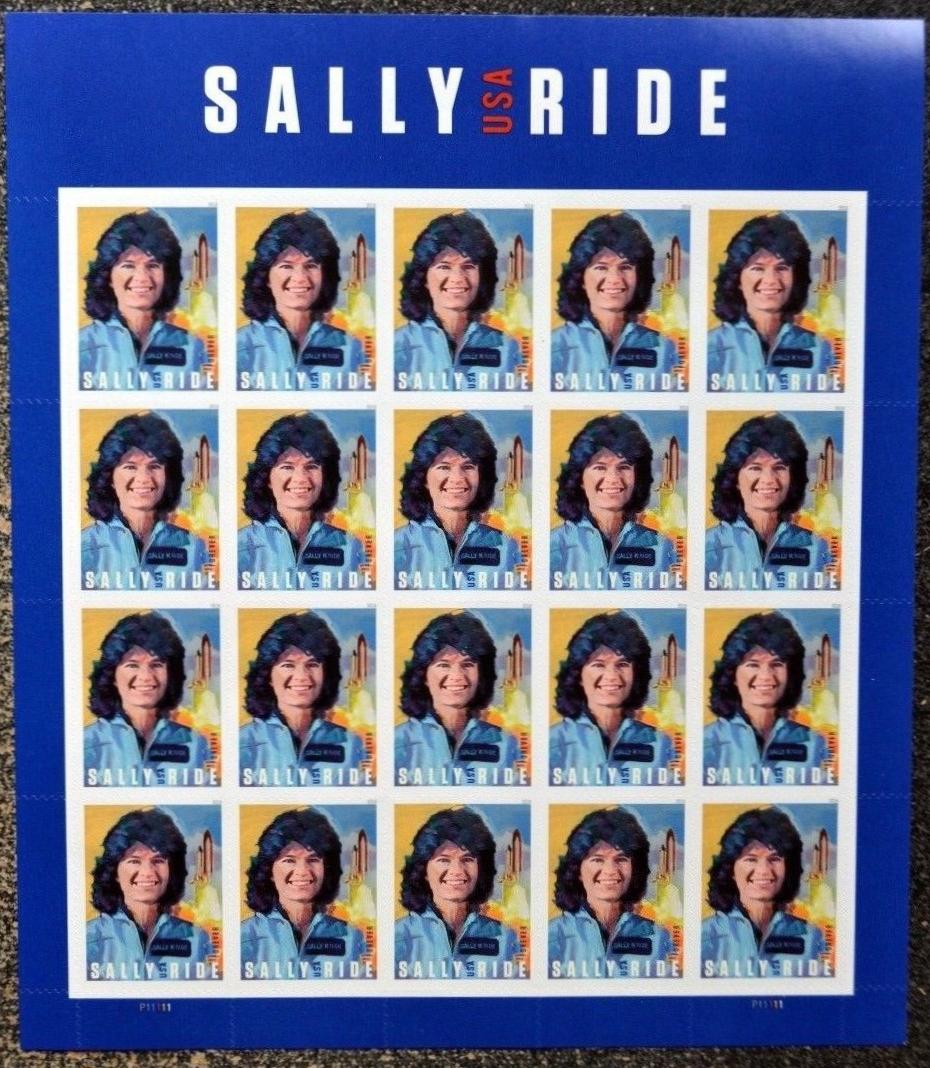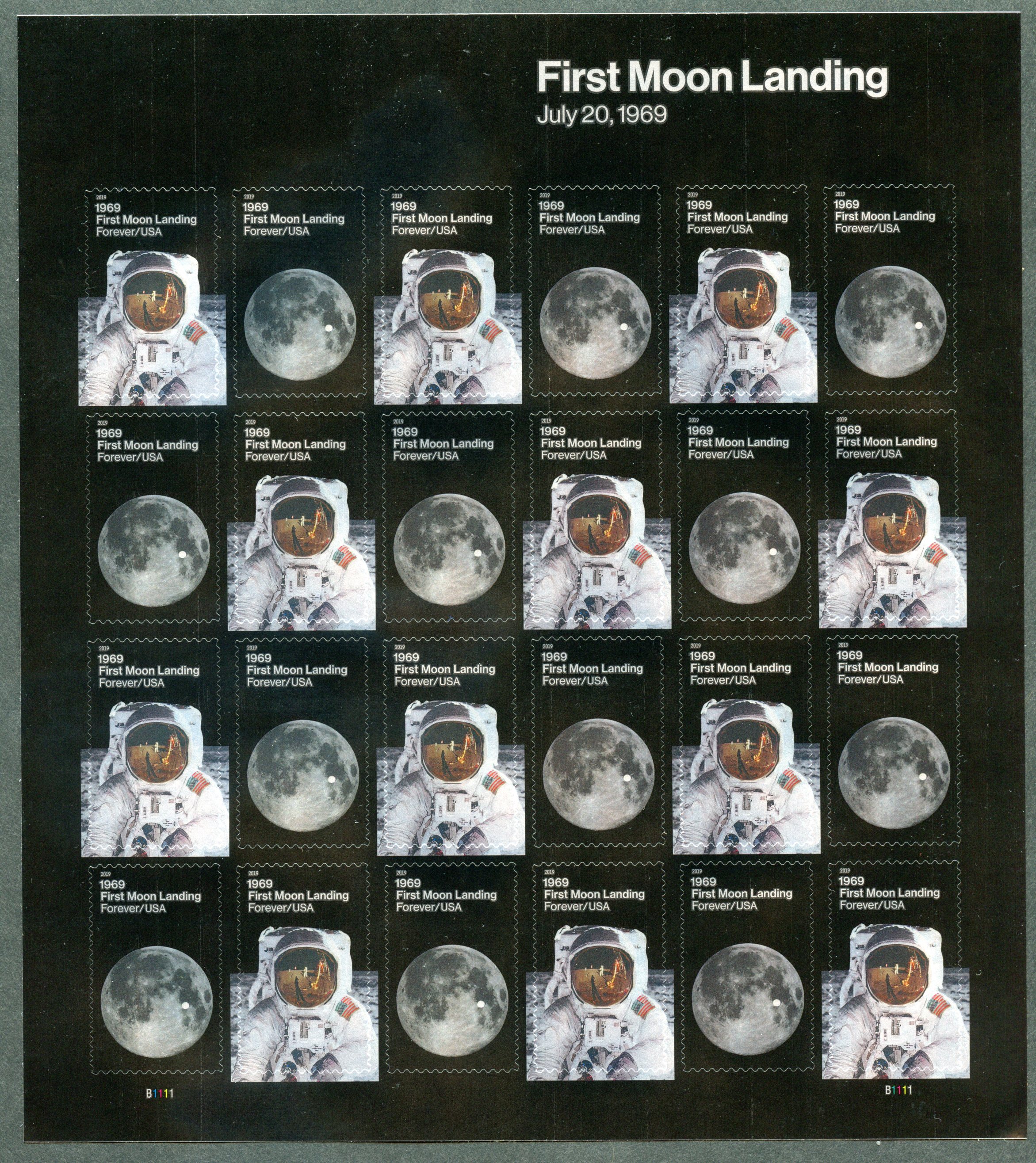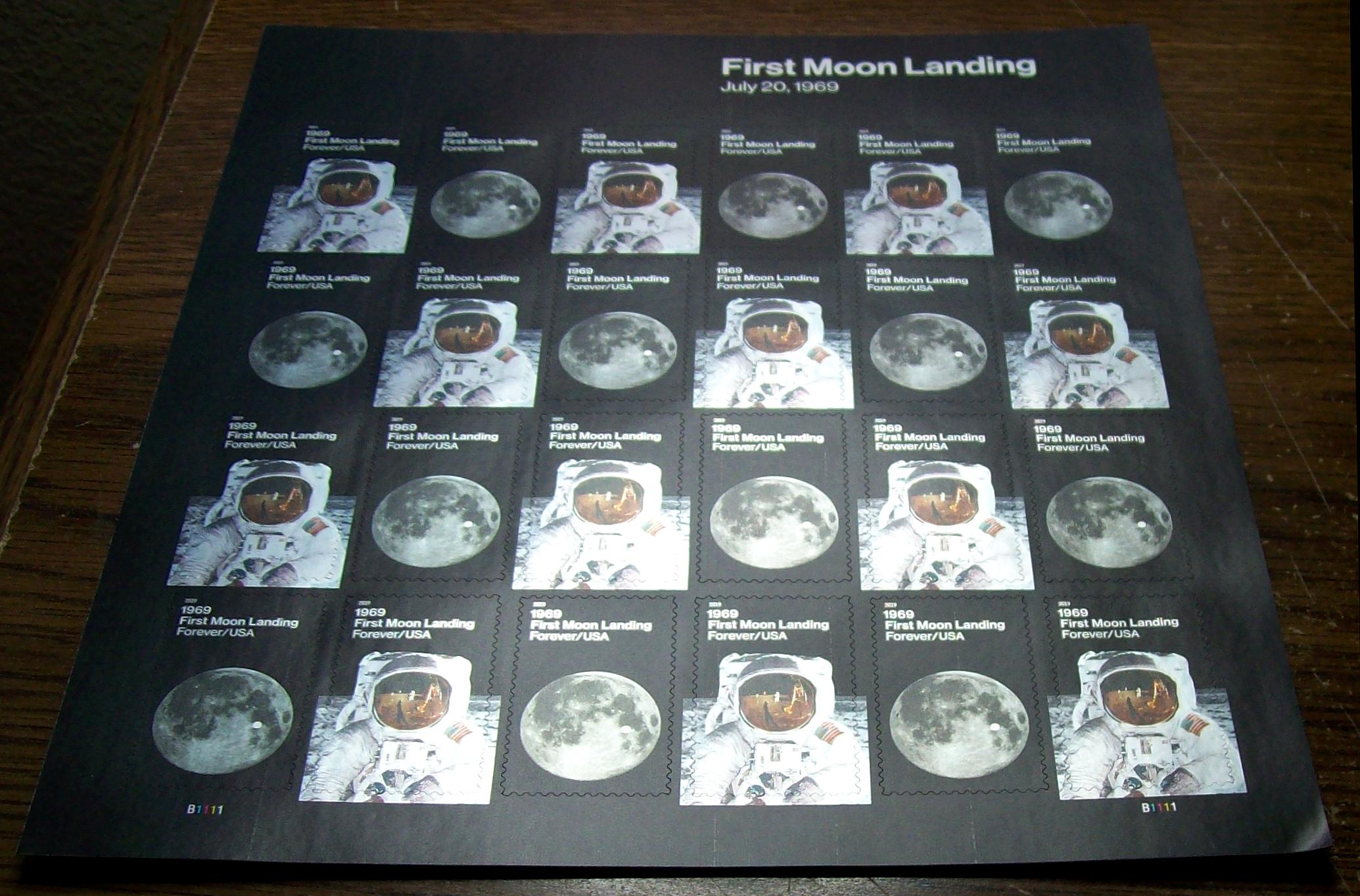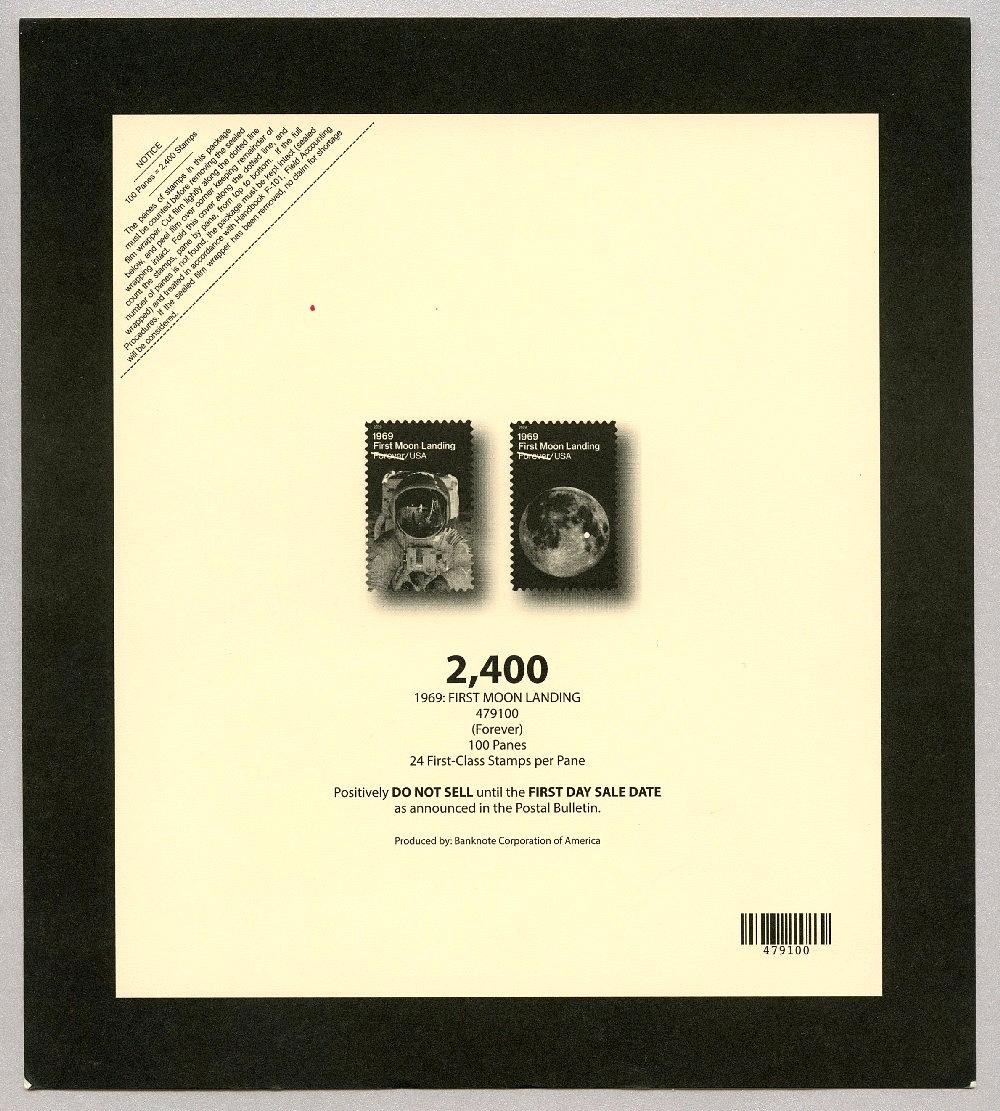*** SPACE-THEMED STAMPS OF THE USA ***
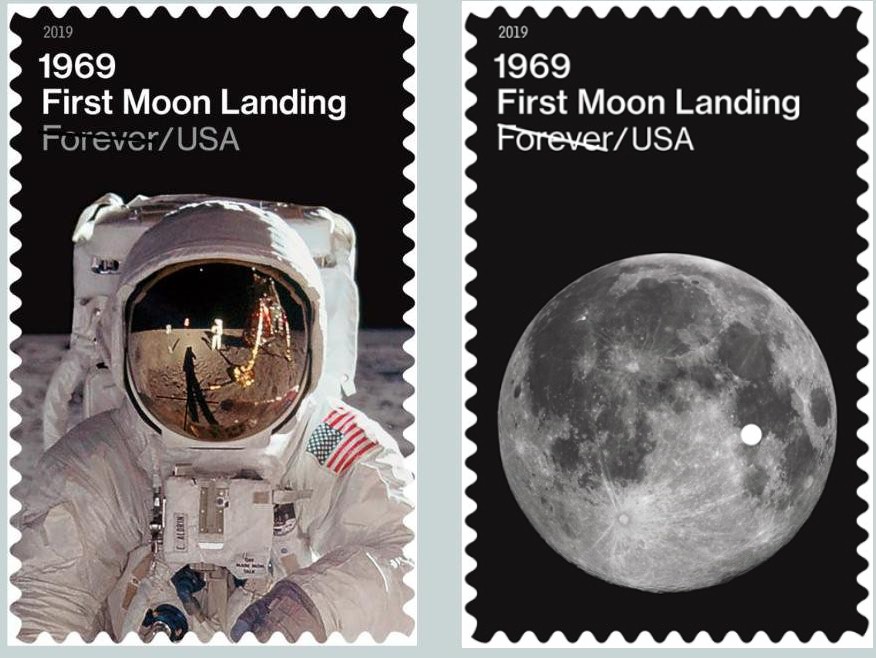
7/12/2019 - July 20, 2019 is the 50th anniversary of the first moon landing, and I just found out that on July 19 the USPS is releasing the pair of stamps shown above to honor the occasion. That got me wondering how many other stamps there had been for that event - American Philatelist, the magazine of the American Philatelic Society, had an article recently about the ones designed by Paul and Chris Calle, so I knew there were at least those four, but are there others? That led me on a search for all of the space-themed stamps the USPS has issued, and what I assumed would be an easy task took a full day - there was no single source with a reliable, complete list! So I have created this one.
Please let me know if there are any I have left out - I have sorted this list by release date. Oh, and by my count there are now SIX USPS stamp issues with seven stamps commemorating the first moon landing. Can you find them all below? Click on any image for a high-res version in a separate window/tab. |
| Scott # Issue date Denom. |
Subject | Comments | Examples |
| 0966 8/30/1948 3¢ |
Mt. Palomar Observatory | This stamp was issued to commemorate the dedication of the 200-inch Hale Telescope, which from 1948 to 1975 was the largest in the world, and still functions as a major astronomical research instrument. |
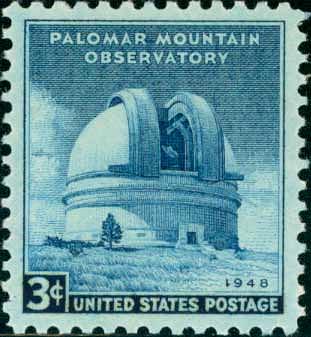
|
| 0976 11/5/1948 3¢ |
Fort Bliss Centennial |
Fort Bliss is a United States Army post in New Mexico and Texas, with its headquarters in El Paso, Texas.
It is the second-largest installation in the Army overall (the largest being the adjacent White Sands Missile Range),
and is used for missile and artillery training and testing.
From the NPM Arago web site: This stamp was issued to honor the 100th anniversary of Fort Bliss in El Paso, Texas. It is probably the best US commemorative stamp for a challenging "stamp trivia" game. "Which United States stamp features a camel on it?" - Scott #976, the Fort Bliss Centennial stamp. "Which stamp was the first stamp to picture a rocket?" - Scott #976, the Fort Bliss Centennial stamp. The stamp's designer, Charles R. Chickering, wanted the stamp to depict the old and the new and portray some of the highlights of Fort Bliss's hundred-year history . . . a tall order for such a tiny painting! The stamp's vignette features a triangularly shaped frame featuring an image of Fort Bliss and a rocket ship in flight. Below the "3c" on the left appears a mountain scene, and below the "3c" on the right appears an old mission. Chickering cleverly used the border of the triangle to engrave a long line around the three sides of men and vehicles, representing "the military of Fort Bliss and the civilians of El Paso and the Southwest" walking down the road together in the hundred-year period. There is a covered wagon drawn by oxen at the lower left, motorized heavy military equipment at lower right, and the camel appears on the upper left near the point of the triangle, just ahead of the horse-drawn stage coach. The color of the stamp, noted as "brown" in the Scott Specialized Catalogue, suggests a desert sunset, while the rocket ship symbolizes modern military operations. |
First US stamp to depict a rocket.
Check out all the tiny details in the triangular border! |
| 1173 12/15/1960 3¢ |
Communications for Peace - Echo I Satellite |
Project Echo was the first passive communications satellite experiment.
Each of the two American spacecraft, launched in 1960 and 1964, was a
metalized balloon satellite acting as a passive reflector of microwave
signals, which were bounced off them from one point on Earth to another.
Echo I was launched on August 12, 1960. |
First US stamp to depict a man-made satellite. |
| 1193 2/20/1962 4¢ |
Project Mercury |
Project Mercury was the first human spaceflight program of the United States,
running from 1958 through 1963. Its goal
was to put a man into Earth orbit and return him safely. Taken over from the US Air Force by the newly created civilian space agency NASA in 1958, it conducted twenty uncrewed developmental flights (some using animals), and six successful flights by astronauts. This stamp was issued on the launch date of Mercury-Atlas 6 (aka Friendship 7), the first American orbital spaceflight. Piloted by astronaut John Glenn, it was the fifth human spaceflight, preceded by Soviet orbital flights Vostok 1 and 2 and American sub-orbital flights Mercury- Redstone 3 and 4. This was the first time the U.S. honoured an event with an unannounced, simultaneously issued commemorative stamp. The stamp features the Space Capsule and a portion of the earth against a star studded background, and was available from 3.3O P.M. on February 20 - the same time and date as the launch. |

|
| C69 10/5/1964 8¢ |
Robert H. Goddard |
Robert Hutchings Goddard (October 5, 1882 - August 10, 1945) was an American engineer,
professor, physicist, and inventor who is credited with creating and building the world's
first liquid-fueled rocket. He has been called the Father of the Space Age.
This stamp was issued on the 82nd anniversary of his birth. |
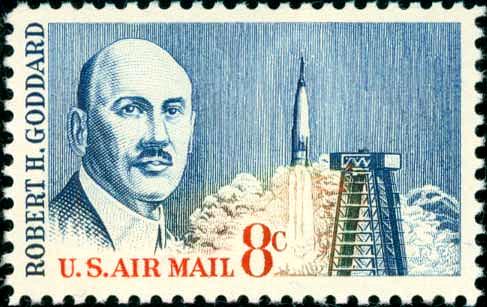
|
| 1331-1332 9/29/1967 5¢ |
Accomplishments in Space | "Space Twins" FIRST US
SETENANT ISSUE Designed by Paul Calle
Commemorates the
first American spacewalk, during Gemini 4 mission, on June 3, 1965.
(The first US setenant of any kind was 1964's Xmas issue,
Scott 1254-57)
|

|
| 1371 5/5/1969 6¢ |
Apollo 8 |
Apollo 8, the second crewed spaceflight mission flown in the United States
Apollo space program
(whose goal was to land humans on the Moon and bring them safely back to Earth),
was launched on December 21, 1968, and became the first
crewed spacecraft to leave low Earth orbit, reach the Moon, orbit it, and return.
The image on the stamp is the famous "Earthrise" photo, taken from the Apollo 8 capsule, and considered by some to be "the most influential environmental photograph ever taken." The phrase of text is from a passage read aloud by the crew on Christmas Eve, 1968. |

|
| C76 9/9/1969 10¢ Airmail |
FIRST MAN ON THE MOON | Designed by Paul Calle
The First Man on the Moon stamp, issued to commemorate the Apollo 11 moon landing on July 20, 1969. It was intended for the 10c domestic airmail letter rate at the time. Designed and engraved in advance of the Apollo 11 mission, its image was based on the artist's idea of what the first astronaut setting foot on the Moon would look like. (And of course there's no way a photograph of that could have been taken, unless some moon man happened to be there with a camera ☺ 👽 ) Paul Calle was a longstanding member of the NASA Fine Arts Program, and the only artist present with the Apollo 11 astronauts on the morning of their historic voyage. Production and release of the stamp was delayed so that its master die could be carried to the Moon by the Apollo 11 crew, and so that the crew could be present at the First Day ceremony! |
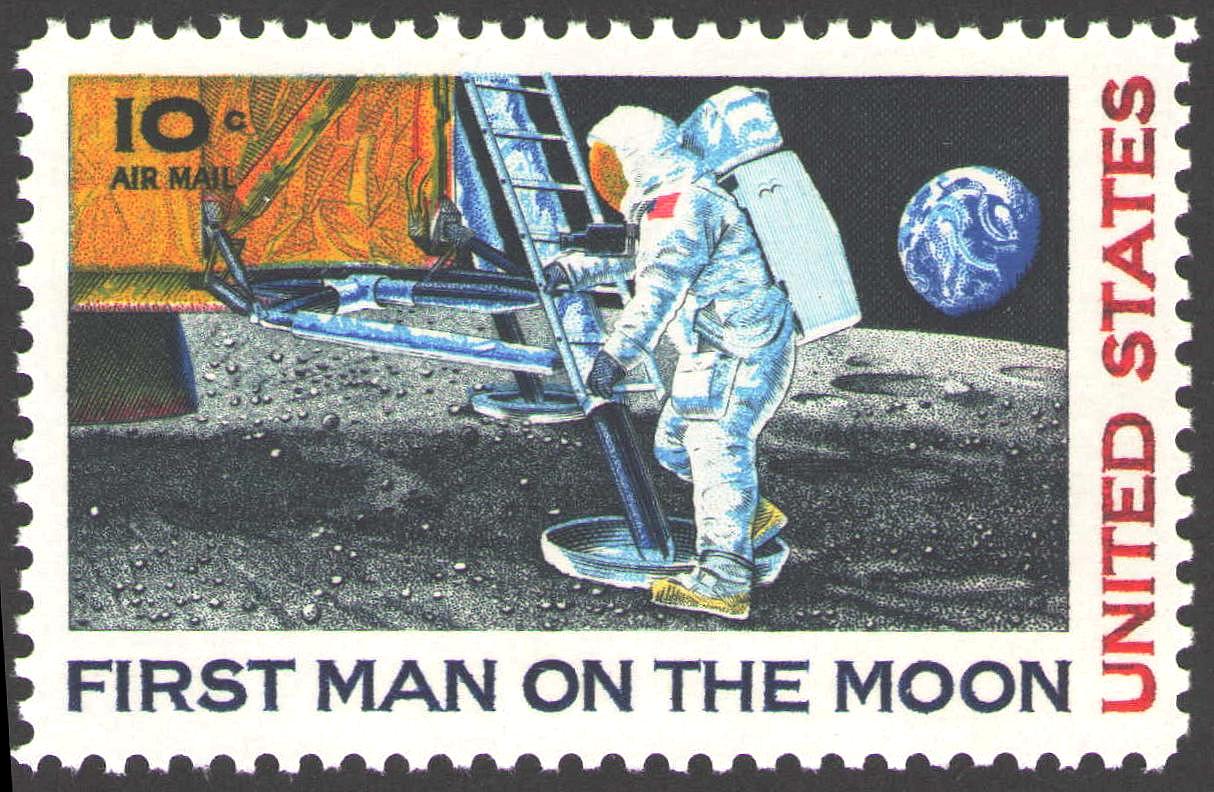
|
| 1434-1435 8/2/1971 8¢ |
US in Space - A Decade of Achivevement |
Celebrates flight of
Apollo XV. The image shows the artist's conception of the Apollo 15 moon exploration mission, July 26 - August 7, 1971, and features astronauts in the Lunar Rover on the moon with space capsule and earth in the background. Note that the stamps were issued while the mission was taking place. The "decade" being commemorated started May 5, 1961, when the US launched its first astronaut, Alan Shepard, on a suborbital flight, Project Mercury MR-3, aka Freedom 7. |

|
| 1488 3/15/1973 8¢ |
Copernicus 500th anniversary of his birth |
Born 19 February 1473, died 24 May 1543 (aged 70).
Copernicus is considered the father of modern astronomy. Based on his observations of the night sky, he originated the helio-centric (sun-centered) model of the universe, challenging the then common idea that our planet was the center of everything. 7/24/19 - I did not have this stamp here at first, but I see other sources that include it, and see its relevance, so I am adding it. |

|
| 1529 5/14/1974 10¢ |
Skylab |
Skylab was the first space station launched and operated by NASA,
occupied for about 24 weeks between May 1973 and February 1974.
It was the only space station that the United States has operated
exclusively. It fell back to Earth amid worldwide media attention in 1979.
NASA launched Skylab in May, 1973. The nine month Skylab program involved three different missions and crews and was designed to test man's ability to adapt and perform in a space environment for long periods of time. The stamp depicts the space walk required for repairs during the second mission. This stamp was issued on the first anniversary of the launch of Skylab. |

|
| 1556 2/28/1975 10¢ |
Pioneer - Jupiter |
The image depicts the
Pioneer 10 space probe (launched March 2, 1972) passing Jupiter in December, 1973.
I have been unable to find any significance to the release date of this stamp. |

|
| 1557 4/4/1975 10¢ |
Mariner 10 - Venus/Mercury |
Launched by NASA on November 3, 1973,
Mariner 10 was the first NASA mission to employ gravity assist, using the gravity of a
planet to alter a spacecraft's speed and trajectory to fly by its target.
The Mariner 10 mission flew by both Venus (February 5, 1974)
and Mercury (3/29/74, 9/21/74, 3/16/75), snapping
photos and collecting data.
I have been unable to find any significance to the release date of this stamp. |

|
| 1569-1570 7/15/1975 10¢ |
Apollo Soyuz |
Joint stamp issue with USSR
Officially called the
Apollo-Soyuz Test Project, this was a joint space mission of the US and the USSR,
July 15 to July 24, 1975. Space capsules sent by each country successfully docked
in space to perform experiments and maneuvers.
These stamps were issued at Kennedy Space Center on the launch date of the
American and Russian capsules.
Russian artist Anatoly Aksamit designed the 'before link-up' image (US Scott 1570),
while American artist Robert T. McCall designed the 'after link-up' image (US Scott 1569).
|

|
| 1759 7/20/1978 15¢ |
Viking Mission to Mars |
The
Viking program consisted of a pair of American space probes sent to Mars
in 1975, Viking 1 and Viking 2. Each spacecraft was composed of two main parts:
an orbiter designed to photograph the surface of Mars from orbit, and a
lander designed to study the planet from the surface. Launched on August 20, 1975, the Viking 1 lander was the first US spacecraft ever to land successfully on Mars. The image on the stamp shows the Viking 1 lander scooping up soil for analysis with a view of Mars from space in the background. The stamp was released on the second anniversary of the Viking I lander's descent to the Mars surface. |

|
| 1912-1919 5/21/1981 18¢ |
Space Achievements |
This 8-stamp setenant issue was released at Kenedy Space Center
to celebrate the first
Space Shuttle flight, April 12-14, 1981. The central four stamps
show views of the Columbia, and the outer four honor other
US Space milestones, both actual and planned.
The eight images, with their inscriptions, are:
I do NOT count this as an issue to honor the 1st Manned Moon Landing.
The stamp at top left says "Exploring the moon," and shows a space-suited
astronaut with tools of some sort - neither the suit nor the tools were
used by the Apollo-11 crew. By the time these stamps were issued
there had been six US manned moon landings, and that stamp was meant to
honor all of them.
|

|
| 1909 8/12/1983 $9.35 Express Mail |
Eagle / Moon |
Issued in booklets of three, this was at the time the most expensive US
stamp ever sold.
Whether this qualifies as a Space Stamp is a matter of opinion, but I am including it because I like it, and for the following additional reasons: First, the moon in the background was from a photo taken by NASA in 1972. Second, the stamp was issued at NASA's Kennedy Space Center. Finally, 260,000 postal covers franked with these stamps were flown on a Space Shuttle mission (STS-8) as cargo, and sold to collectors with a special folder. |

|
| 2122 4/29/1985 $10.75 Express Mail |
Eagle / Moon |
Issued in booklets of three.
Whether this qualifies as a Space Stamp is a matter of opinion, but I am including it because I included 1909, and its design is essentially the same. There are two versions of this stamp. TYPE I has plate number 11111. The second version, 2122b - TYPE II, is described as "smoother, brighter, less grainy," and has plate number 22222. |

2122 - Issued 4/29/1985 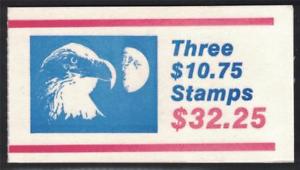
|
| 2277 2279 2282 3/22/1988 25¢ "E" rate change stamp |
Earth from space |
Issued as a sheet stamp, a booklet stamp, and as a coil, - because it was a definitive, the only one on this page - to cover the change from 22¢ to 25¢ for the basic US postage rate. Whether this qualifies as a Space Stamp is a matter of opinion, but I am including it because a collector wrote me to plead its case. His reasoning was that the design is based on photos taken by the astronauts on early moon flights, so that makes it a space stamp. According to Arago, Designed by Robert T. McCall, veteran space stamp designer from Paradise Valley, Arizona, the image comes from an original painting based on composite photographs provided by the National Aeronautic and Space Administration (NASA). The photo image at right was offered by the proposer as the actual model for the stamp, and I agree it shows a very similar view of our planet, but if you compare its cloud patterns with those in the stamp, they are clearly different. I confess I like the photo better than the painted version, frankly, cloud-wise. ------- 2/20/21 - NOTE CHANGE IN DATE OF ISSUE - I had 4/3/88 - no idea where I got that, but 3/22/88 is the correct date. My bad. |
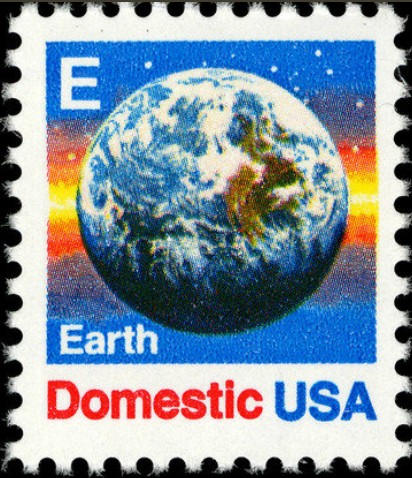
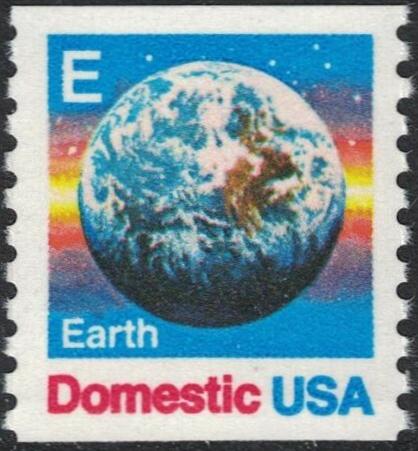
2277 - Issued 3/22/1988 |
| 2394 10/04/1988 $8.75 Express Mail |
Eagle / Moon |
Issued in panes of 20 (!)
Whether this qualifies as a Space Stamp is a matter of opinion, but I am including it because I included 1909, and its design is essentially the same. |

|
| 2419 7/20/1989 $2.40 Priority Mail |
20th Anniversary of 1st Manned Moon Landing | Designed by Chris Calle
The stamp's image is Calle's prettied-up version of the scene in the
photo, which was extracted from film of the event, shot by a camera
mounted on the lunar lander. Neil A. Armstrong stands on the left at the
flag's staff. Edwin E. Aldrin Jr. stands on the right.
Technically, though, the image was
based on NASA photographs of astronauts practicing various maneuvers before the actual flight.
|

|
| C126 11/24/1989 45¢ Airmail |
20th UPU Congress - Futuristic Mail Delivery | Souvenir sheet - imperf Issued at World Stamp Expo 1989, Washington, DC A glimpse at several potential mail delivery methods of the future is the theme of these four stamps issued by the U.S. in commemoration of the convening of the 20th Universal Postal Congress in Washington, D.C. from November 13 through December 14, 1989. The United States, as host nation to the Congress for the first time in ninety-two years, welcomed more than 1,000 delegates from most of the member nations of the Universal Postal Union to the major international event. |
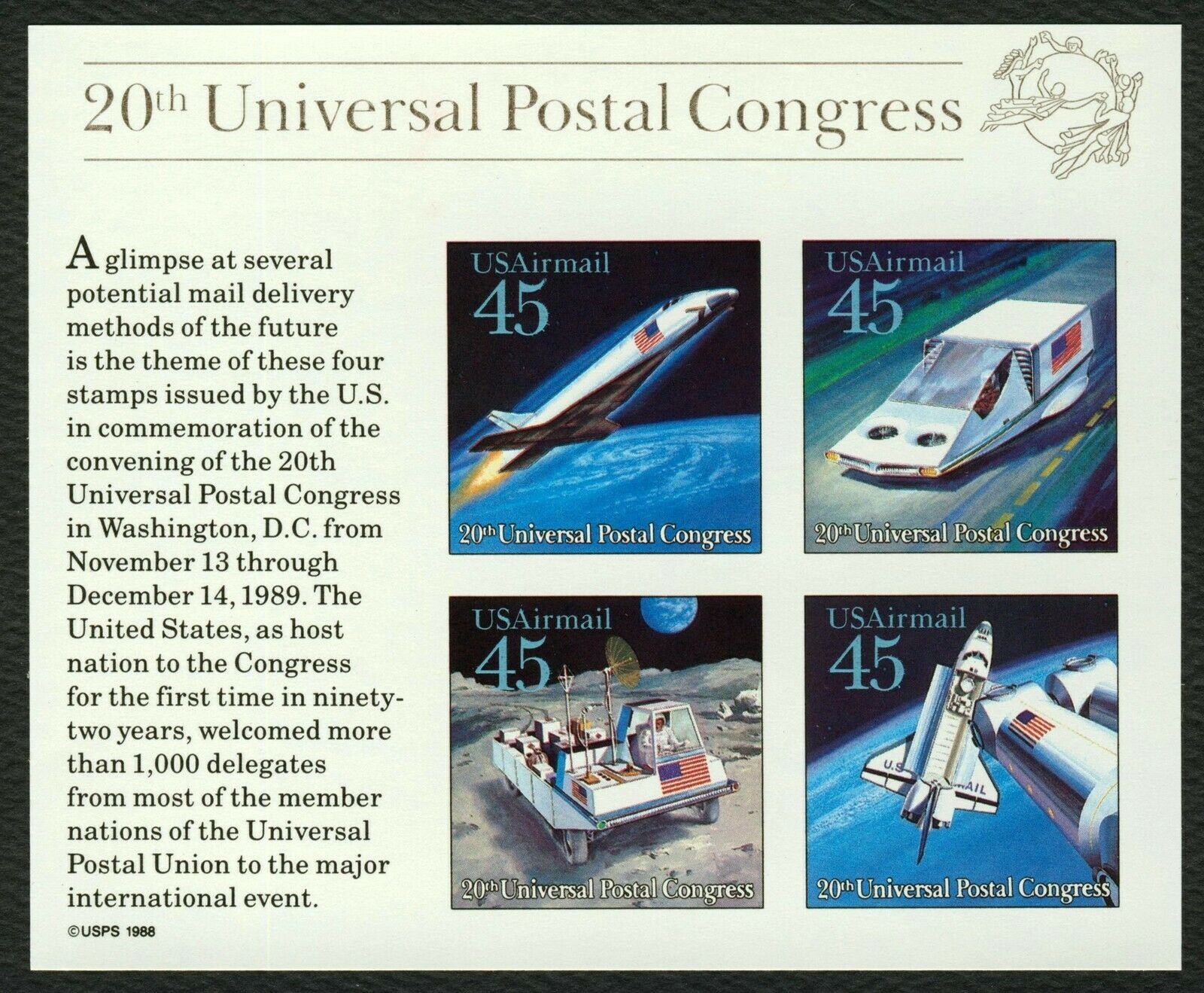
|
| C122-C125 11/27/1989 45¢ Airmail |
20th UPU Congress - Futuristic Mail Delivery |
Issued at World Stamp Expo 1989, Washington, DC
The four stamp images are described as "Hypersonic Airliner, Air-suspended Hover Car,
Moon Rover, and Space Shuttle."
Four additional stamps were issued at the same time, with the 25 cent surface mail
postage rate, and depicting "Traditional Mail Delivery." They have no space
connection, of course, but it seemed wrong not to show them too.
|
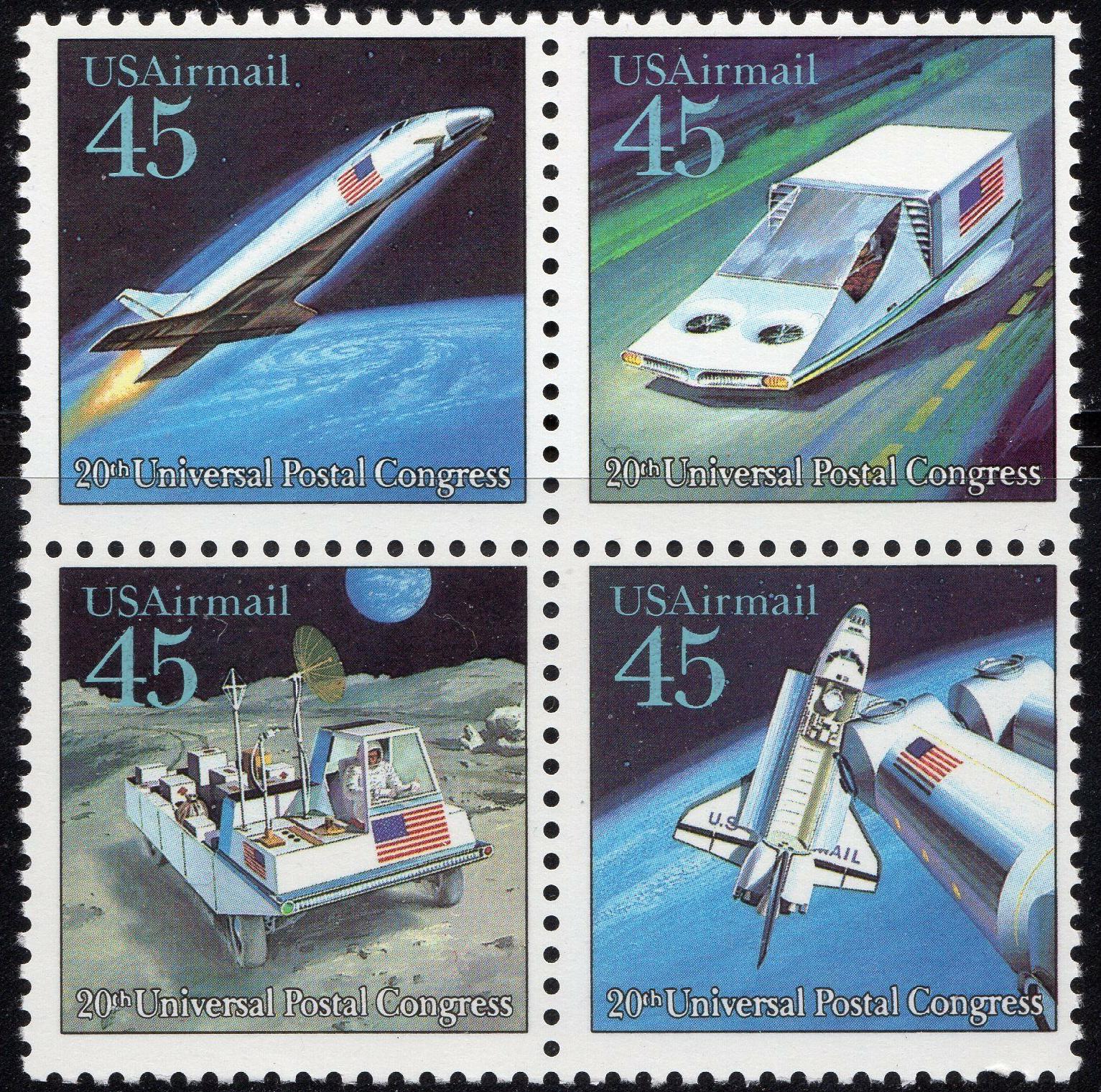
|
| U617 12/3/1989 25¢ |
Shuttle Docking at Space Station
(Artistic fantasy) |
Issued at World Stamp Expo 1989, Washington, DC,
and designed by the same artist that did the Futuristic Mail
Delivery stamps, above.
Image is a Hologram,
FIRST hologram on a USPS postal item - first STAMP with a hologram is also
a space issue - see 3412, below
|
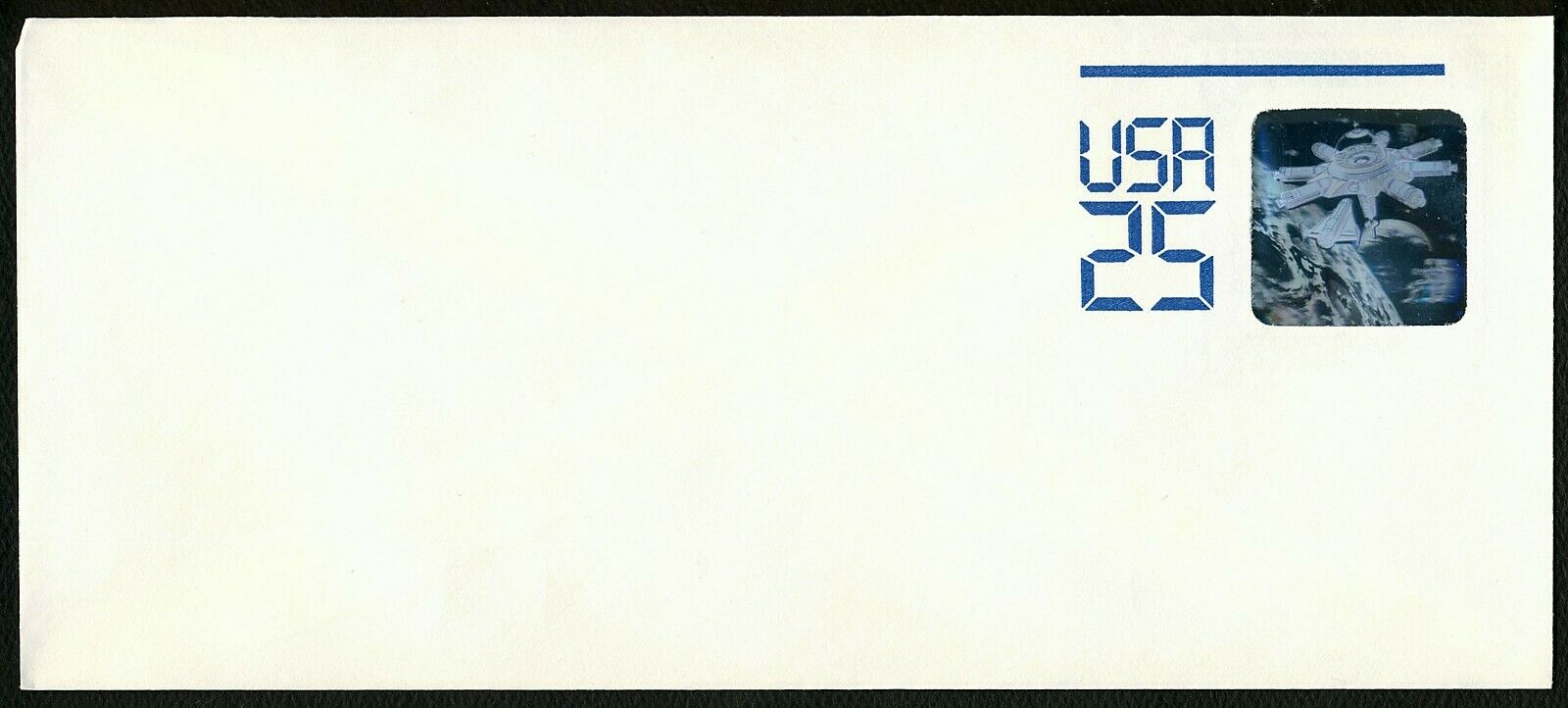
|
| 2568-2577 10/1/1991 29¢ |
Space Exploration |
The ten stamps feature the nine planets and the Earth's Moon, along with the
unmanned spacecraft that had visited each (with the exception of Pluto).
The stamp's issuance kicked off National Stamp Collecting Month, which is always October. (Pluto was still considered a planet, way back then.) |

|
| U625 1/21/1992 29¢ |
Shuttle Docking at Space Station |
NEW POSTAL RATES
Image is a Hologram, This is the same hologram as U617, just repurposed |
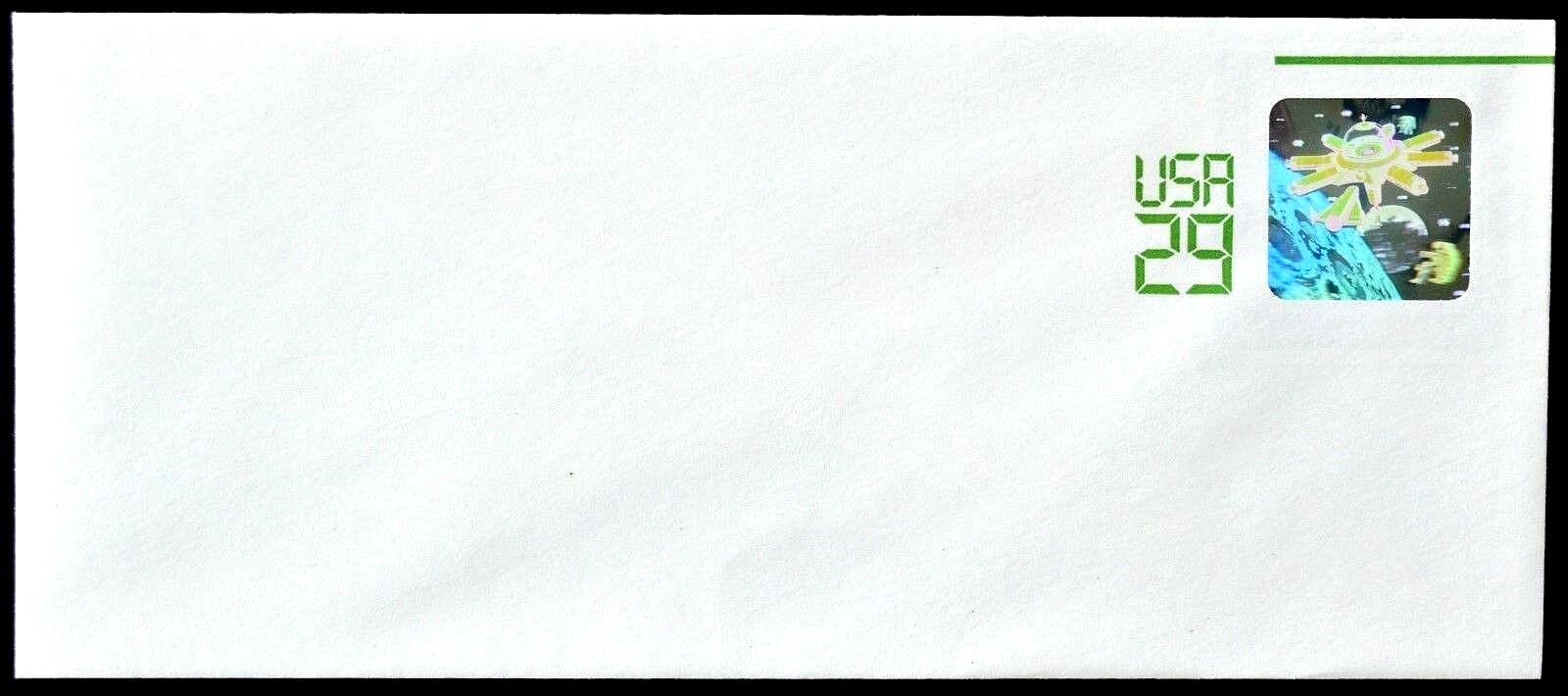
|
| 2631-2634 5/29/1992 29¢ |
Space Accomplishments | US and Russian Achievements Joint issue with USSR
Issued May 29, 1992, at the WORLD COLUMBIAN STAMP EXPO '92 in
suburban Chicago, IL.
The se-tenant composite design was developed in a joint collaboration
by American artist Robert T. McCall and Russian artist Vladimir Beilin,
and featured most of the significant achievements in space exploration in the
previous 35 years, with equal emphasis to the achievements of each country.
The top two stamps show astronauts of each country on space-walks
(Russian on the left, American on the right).
The lower left stamp shows Sputnik, Vostok, Apollo Command and Lunar Modules
while the lower right stamp shows
Soyuz, Mercury and Gemini Spacecraft.
|

|
| 2741-2745 1/25/1993 29¢ |
Space Fantasy | I cannot find any special significance to the date or the stamps designs - just a fun pentad of fantasy space exploration images, reminiscent of 1930s comic books and pulp magazine covers. |

|
| 2543 6/3/1993 $2.90 Priority Mail |
Futuristic Space Shuttle |
According to
Arago, the stamp web site of the National Postal Museum
The Postal Service issued a $2.90 Priority Mail stamp on June 3, 1993, at the Kennedy Space Center in Florida. The issuance was in conjunction with a Space Shuttle launch scheduled that day. The stamp features a futuristic shuttle in space. |

|
| 2841 7/20/1994 29¢ |
25th Anniversary of 1st Manned Moon Landing | Designed jountly by Paul & Chris Calle, father and son artists, each of whom had designed one of the prior two Moon Landing stamps. |

|
| 2842 7/20/1994 $9.95 Express Mail |
25th Anniversary of 1st Manned Moon Landing | Designed jountly by Paul & Chris Calle, father and son artists, each of whom had designed one of the prior two Moon Landing stamps. |
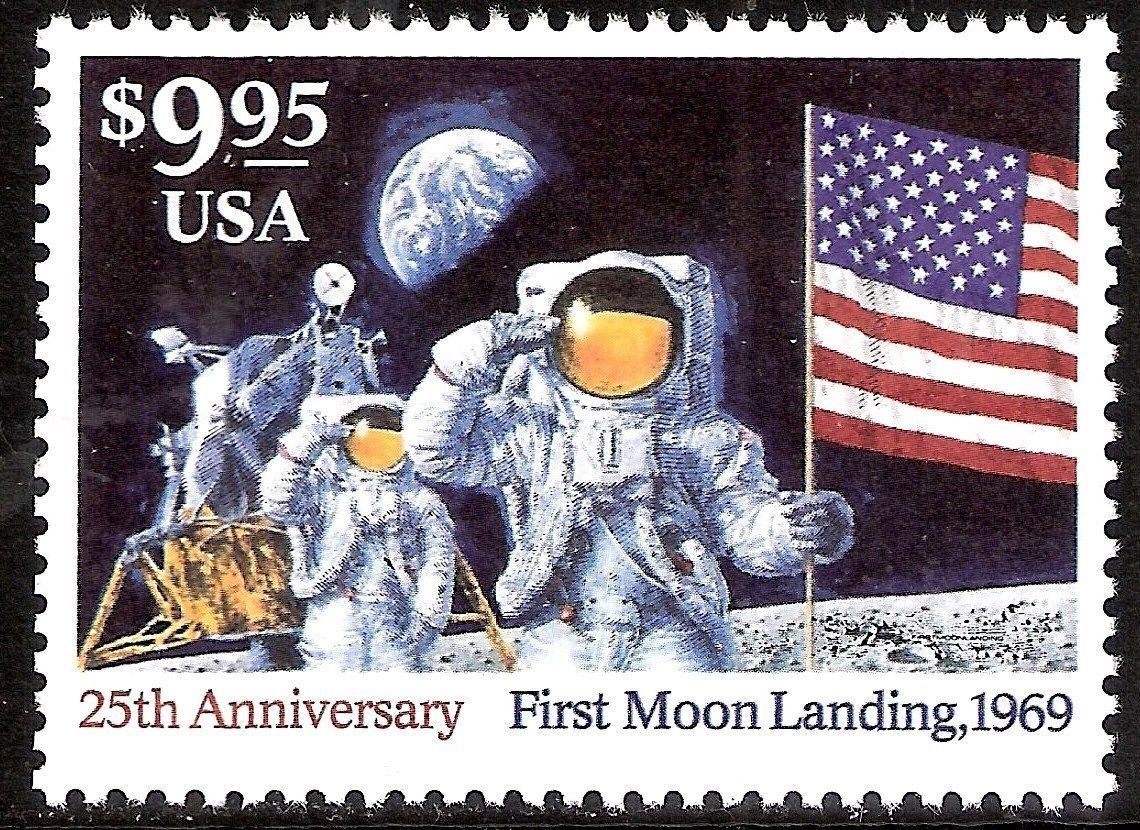
|
| 2544 6/22/1995 $3.00 Express Mail |
Space Shuttle Challenger |
Original printing, with "1995" in lower left corner
According to Arago:
The Postal Service commemorated the Challenger Space Shuttle mission STS-7 (June 18-24, 1983) with the issuance of a 3-dollar stamp on June 22, 1995 in Anaheim, California. STS-7 was NASA's seventh Space Shuttle mission, and the second mission for the Space Shuttle Challenger. Sally Ride became the first American woman to fly in space. During the mission, Challenger deployed several satellites into orbit. On the stamp, the mission number was printed in microtype and hidden within the image "for security reasons." It also appears in the lower right corner of the design, outside the image area, directly opposite the 1995 year inscription. This was the first time that the Postal Service used an actual photograph from a National Aeronautics and Space Administration mission, instead of an illustration based on a photograph. |

The microprinted "STS-7" is just below the middle of the image, on the white rocket hood - see it? |
| 2544A 8/4/1995 $10.75 Express Mail |
Space Shuttle Endeavor | The stamp depicts the liftoff of the Endeavour Space Shuttle, Mission STS-57, which took place on June 21, 1993, from Kennedy Space Center, Florida. |
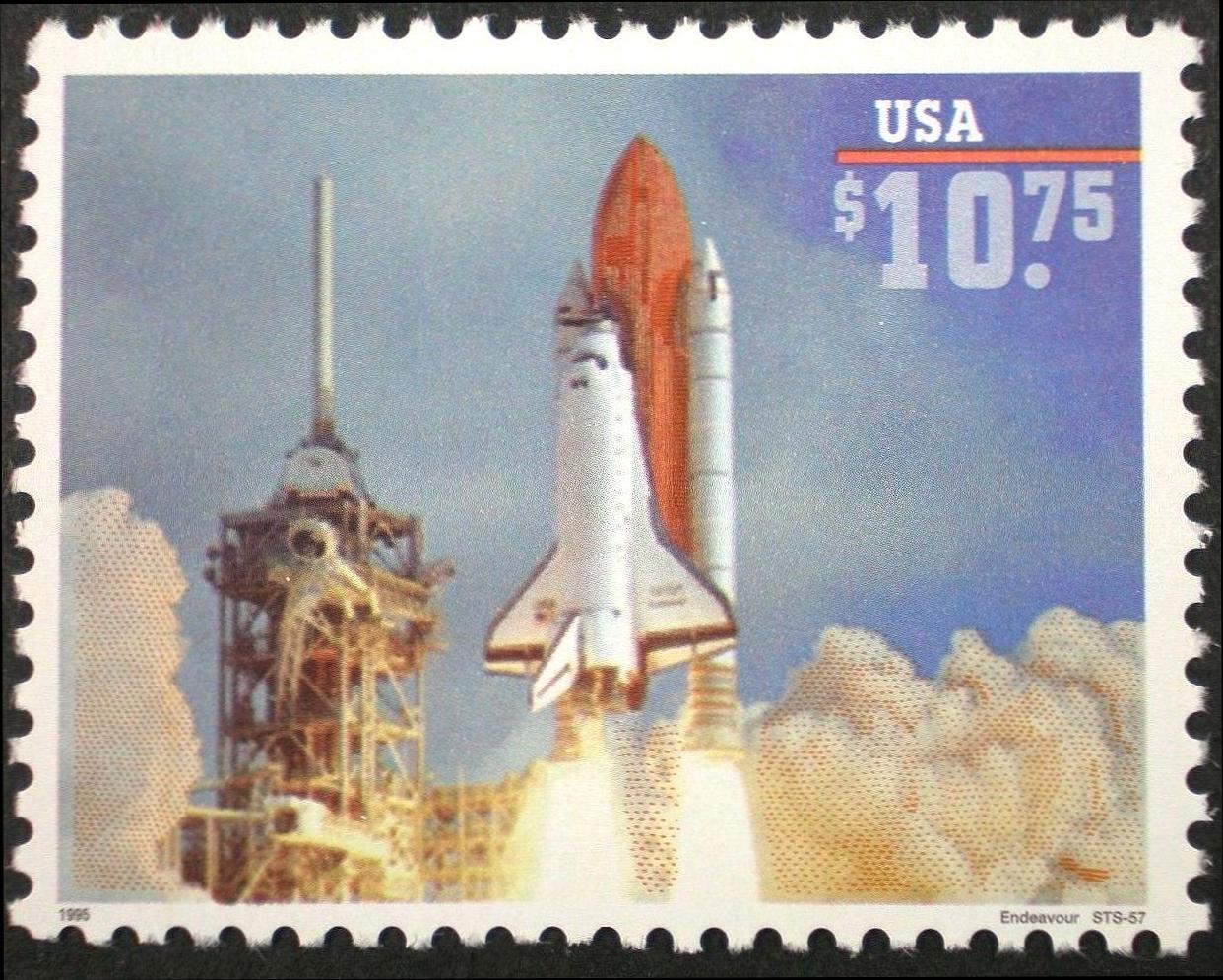
|
| U639 9/22/1995 32¢ |
Shuttle Docking at Space Station |
NEW POSTAL RATES
Image is a Hologram, This is the same hologram as U617, just repurposed. Either the dsesign was very popular, or they had a LOT of the holograms, and wanted to use them all up. |
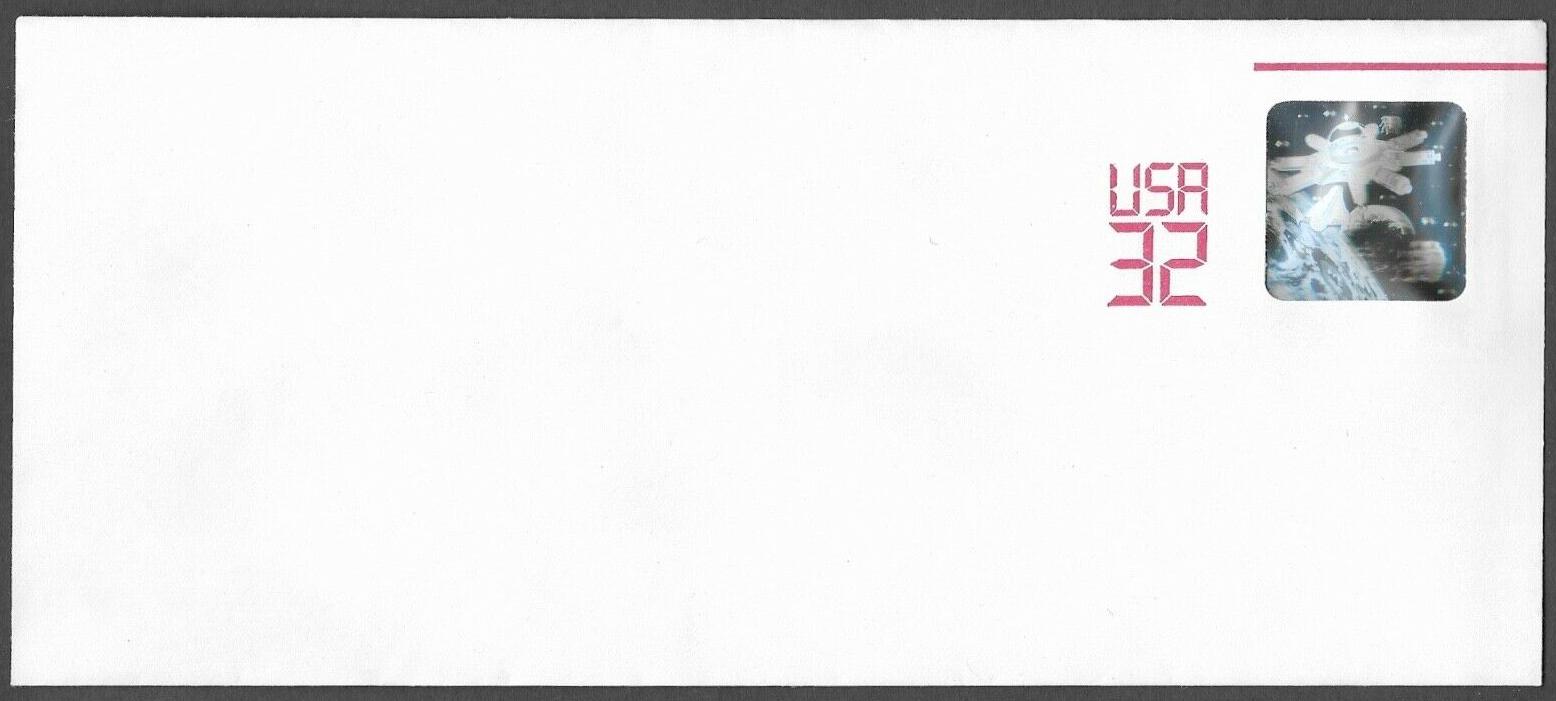
|
| 2544b 1996 $3.00 Priority Mail |
Space Shuttle Challenger |
Reprinted with "1996" in lower left corner -
still has the microprinted "STS-7" on engine housing
just below middle of image.
No official release date |
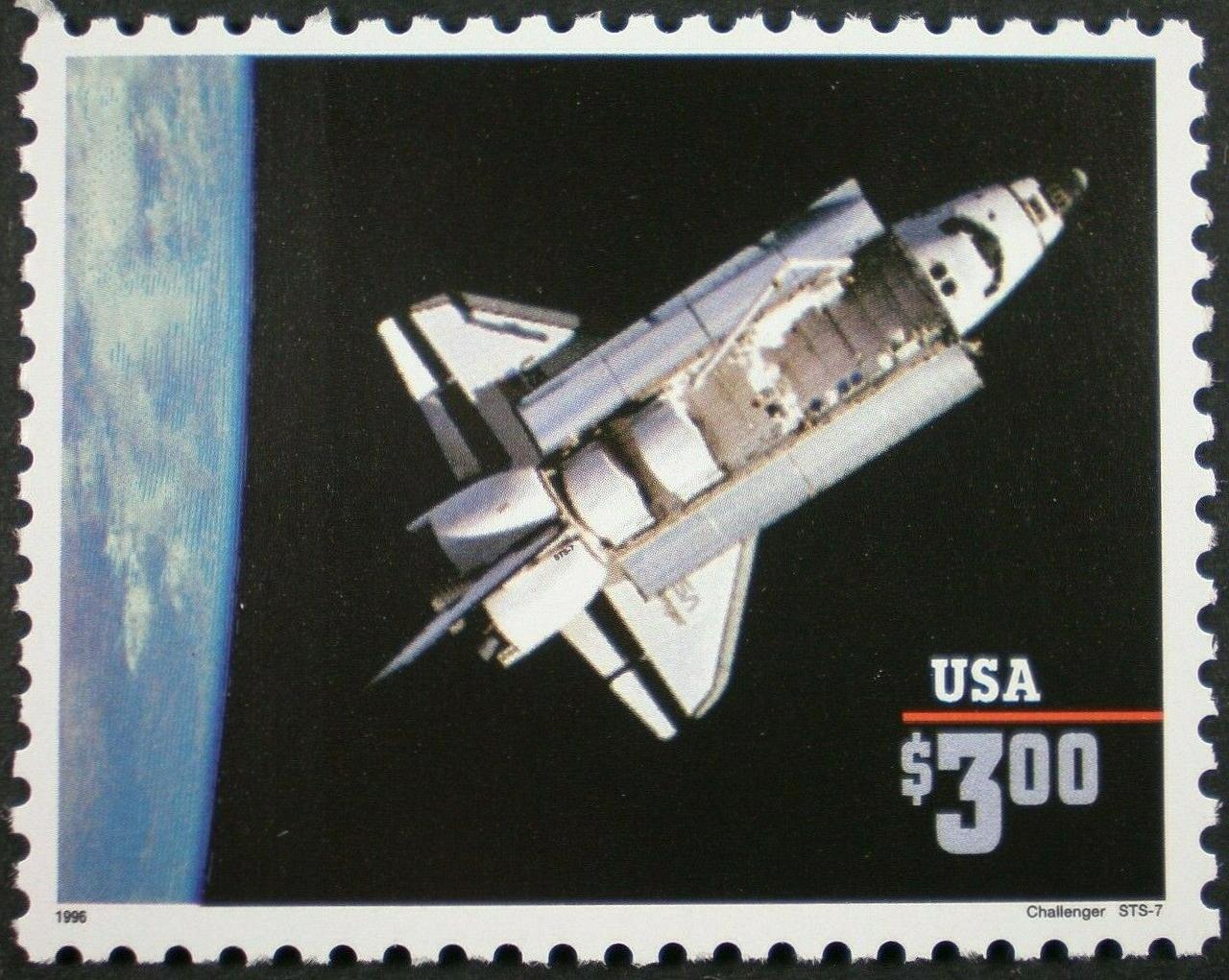
|
| 3178 12/10/1997 $3.00 Priority Mail |
Mars Pathfinder |
According to Arago: The stamp features the Sojourner rover resting on the Pathfinder with a panoramic view of the Ares Vallis region of Mars in the background. Only 15 million stamps were produced, and the stamps went on sale for just six months. The printing plates were immediately destroyed to ensure that no additional quantities of this unique stamp would be reprinted. As with selected previous issues, the stamp featured a hidden message, visible only through the USPS Stamp Decoder. Another unique feature of this stamp is the letters "USA" in the stamp perforation. It was also the largest postage stamp (38mm x 76mm) produced by the Postal Service to that date. |

Launch date - 12/4/96; Landing date - July 4, 1997 |
| 3238-3242 10/1/1998 32¢ |
Space Discovery | Fantasy views of future space colony - released
at Kennedy Space Center, Florida.
Given the release date, I assume this was the USPS kickoff to Stamp Collecting Month that year. |
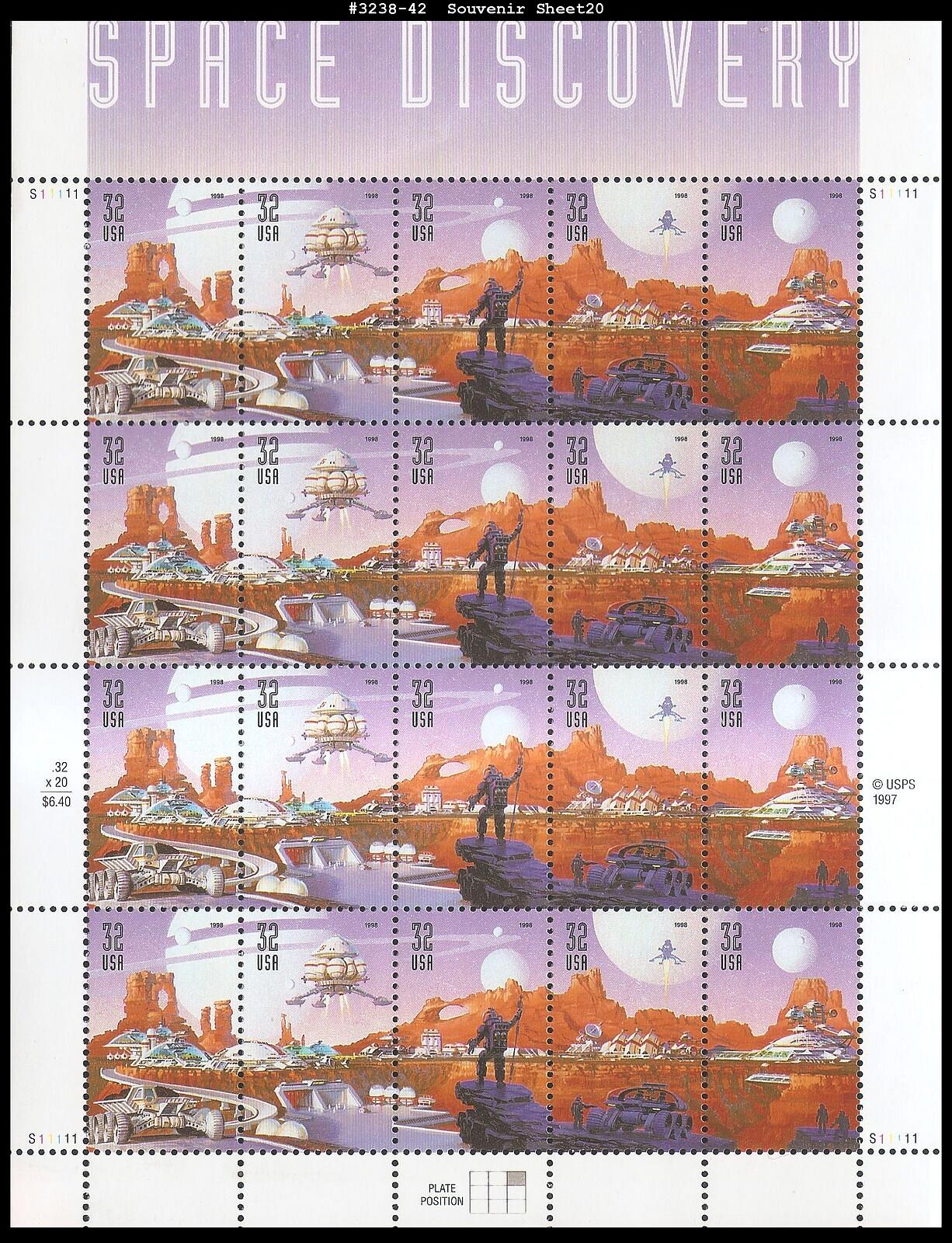
|
| 3261 11/9/1998 $3.20 Priority Mail |
Space Shuttle Landing with Parachute | The image is based on a photograph taken by NASA. |

|
| 3262 11/19/1998 $11.75 Express Mail |
Piggyback Space Shuttle |
Issued in conjunction with the first day of the 1998 Postage Stamp Mega Event.
These shows are staged once or twice a year by the ASDA and USPS, starting about 1992. The image is based on a photograph taken by NASA. |

|
| 3187d 5/26/1999 33¢ |
US launches satellites |
the 1950s
From February of 1998 through May of 2000, the USPS
issued a set of 10 of these sheets, one per decade
of the 20th century,
each depicting 15 important events of its decade.
Some of their designs were voted on by the public.
Their format seemed designed to discourage use of the stamps. |
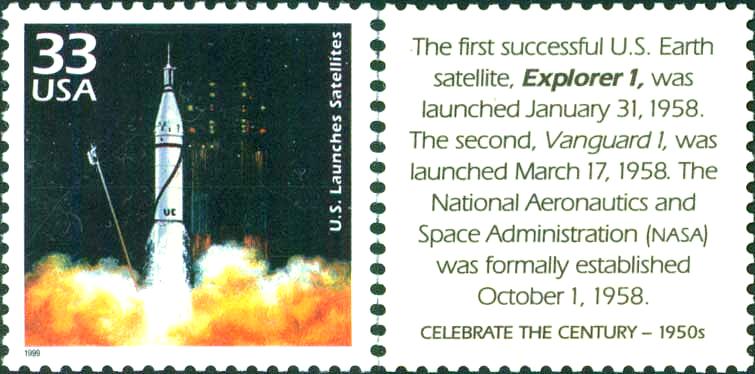
|
| 3188c 9/17/1999 33¢ |
Man walks on the moon |
the 1960s
|
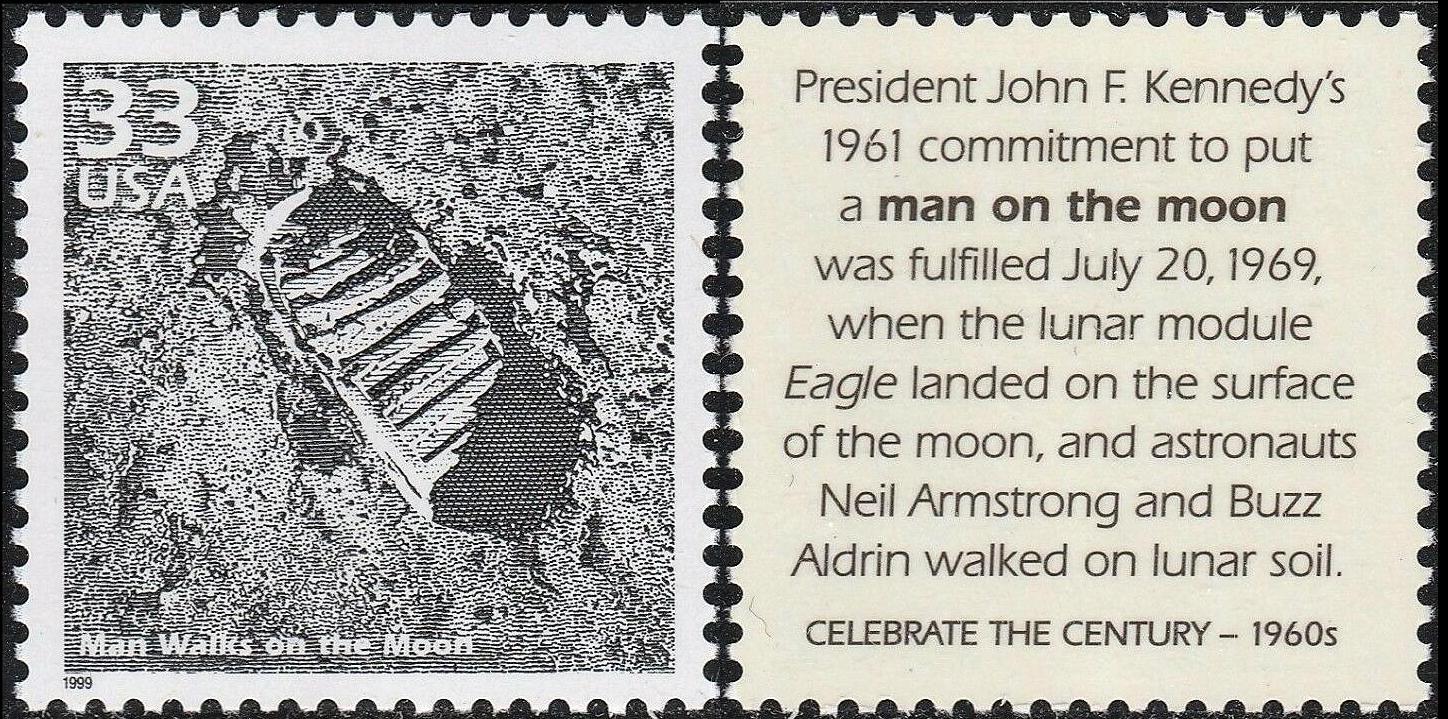
|
| 3189a &
3189i 11/18/1999 33¢ |
Earth Day Pioneer 10 |
the 1970s
|
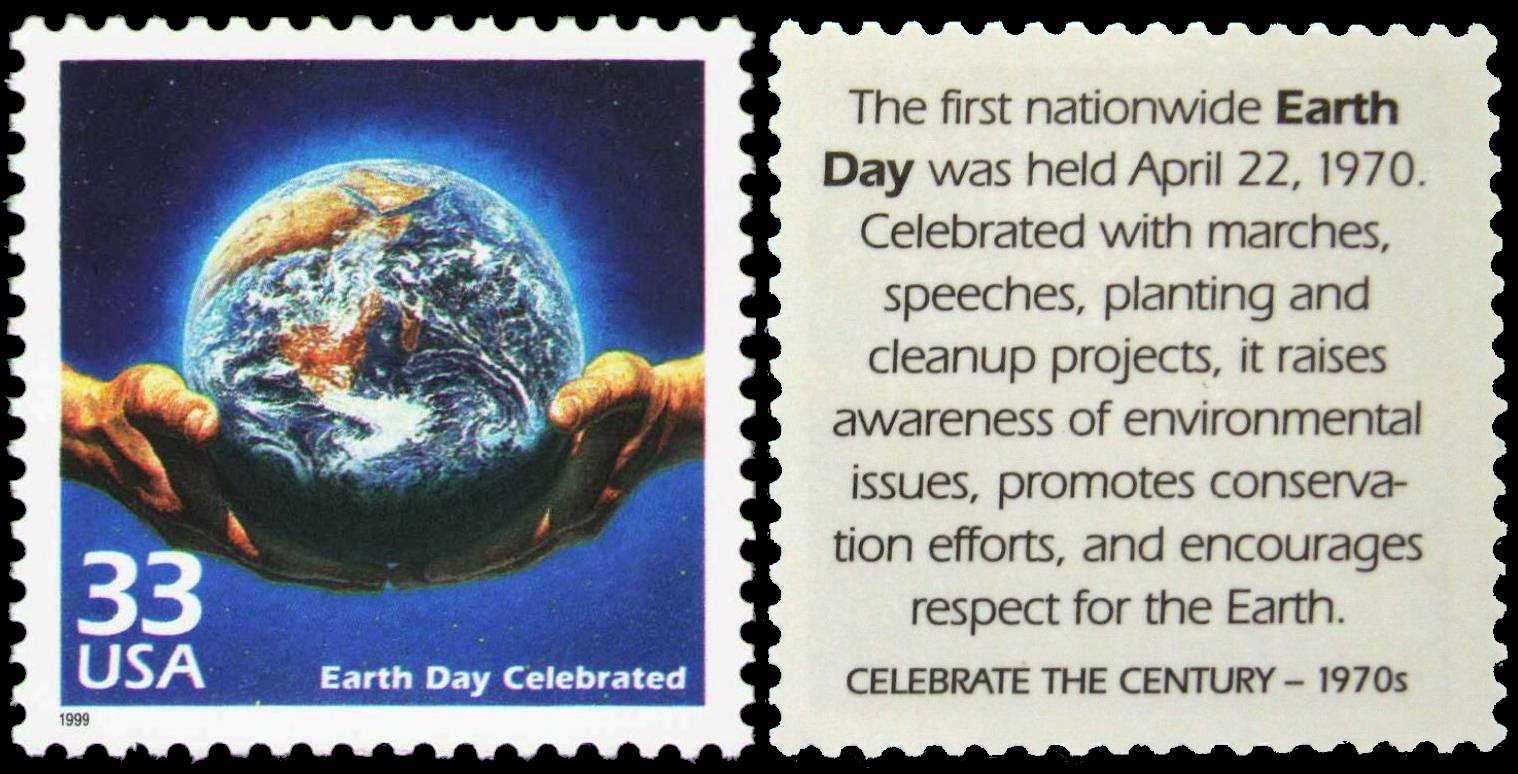
Is this a space stamp? You decide. |
| 3190a 1/12/2000 33¢ |
Space shuttle program |
the 1980s
|
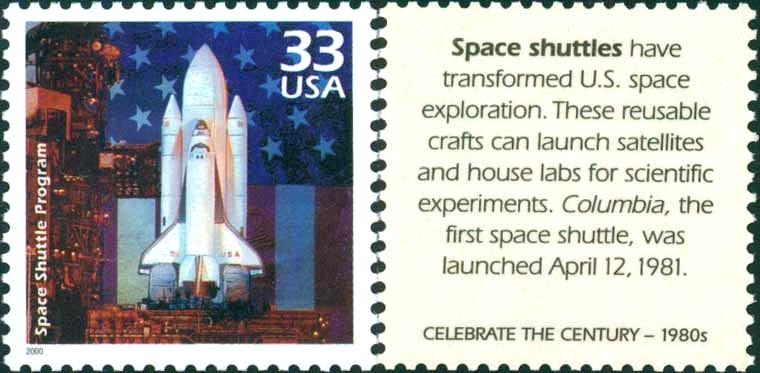
|
| 3384-3388 4/10/2000 33¢ |
Hubble Telescope |
Arguably one of NASA's best-known and most popular
achievements, the Hubble Space Telescope got off to
a rocky start: Delivered into its orbit by Space Shuttle
Discovery during STS-31 on April 24, 1990, it turned out to have a serious
design flaw that rendered its optical telescope essentially
useless. After a major overhaul during STS-61 on 12/9/1993
it was declared fully operational, and has delivered thousands
of breathtaking images ever since.
These stamps honored both the telescope and its namesake, Edwin Hubble, one of the greatest astronomers of all time. Hubble redefined our concept of the Universe with his discoveries, proving that our Milky Way is just one of an infinite number of galaxies, and that the Universe is expanding. |

|
| 3191h 5/2/2000 33¢ |
Return to space |
the 1990s
|
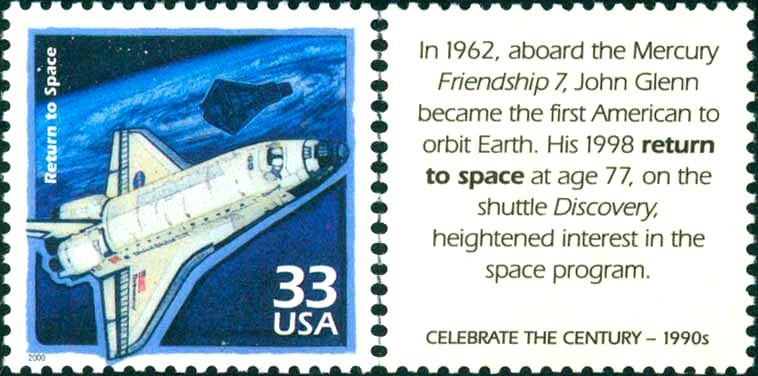
|
| 3412 7/7/2000 $11.75 Express Mail |
Space Achievements and Exploration |
1st USPS holographic stamp
1st USPS circular stamp Issued at WSE 2000
Arago:
The Postal Service issued an 11.75-dollar Space Achievement and Exploration
souvenir sheet featuring a circular commemorative stamp, the first ever issued
by the U.S. Postal Service, in Anaheim, California, on July 7, 2000. The stamp
was designed by Richard Sheaff of Scottsdale, Arizona, based on a NASA photograph.
This Express Mail stamp features a hologram of the Earth, another first for
the U.S. Postal Service. The text encircling the stamp reads "Space Achievement
and Exploration" and "World Stamp Expo 2000." This stamp was the first issued
in the Space Achievement and Exploration Commemorative Series and was the first
to be unveiled at the World Stamp Expo 2000 in honor of America's space program.
|

|
| 3413 7/8/2000 $11.75 Express Mail |
Landing on the Moon |
Hologram
Issued at WSE 2000
I thought the background image might be from the first moon landing, but
according to Arago:
The Postal Service issued an 11.75-dollar Landing on the Moon souvenir sheet
with one commemorative stamp in Anaheim, CA, on July 8, 2000. The stamp was
designed by Richard Sheaff of Scottsdale, Arizona.
This sheet features a single stamp with a hologram of a lunar lander based on
computer and three-dimensional models from NASA. The selvage photograph was
taken by astronaut John W. Young during the Apollo 16 mission in April 1972. It
depicts astronaut Charles M. Duke, Jr. on the surface of the moon with a lunar
rover in the background
|

|
| 3411 7/9/2000 $3.20 Priority Mail |
Escaping the Gravity of Earth |
Holograms
Issued at WSE 2000
Arago:
The Postal Service issued two 3.20-dollar Escaping the Gravity of Earth
commemorative stamps on a souvenir sheet in Anaheim, CA, on July 9, 2000. The
stamps were designed by Richard Sheaff of Scottsdale, Arizona.
These two Priority Mail stamps feature holograms of the International Space
Station and represent American technology solving the problems of escaping the
gravitational pull of Earth and learning how to send missions into Earth's
orbit. The hologram on the left stamp is based on a computer-generated NASA
image. The hologram on the right stamp is based on a NASA artist's conception of
the International Space Station. The selvage photograph depicts astronauts David
Leesma and Kathryn Sullivan in the open cargo bay of the Challenger space
shuttle during an October 1984 mission.
|

|
| 3409 7/10/2000 60¢ 1/2-ounce International rate |
Probing the Vastness of Space |
Issued at WSE 2000
Arago:
The Postal Service issued a souvenir sheet featuring six individual 60-cent
Probing the Vastness of Space commemorative stamps in Anaheim, California, on
July 10, 2000. The stamps, designed by Richard Sheaff of Scottsdale, Arizona,
are based on photographs described below. These six stamps were issued in
international rate denominations and address the exploration of deep space.
The 2.4-meter optical telescope is a conceptual drawing of NASA's Hubble Space
Telescope by artist Vincent Di Fate. The radio interferometer is a photograph by
David Nunuk depicting the National Science Foundation's very large array on the
plains of San Agustin, west of Socorro, NM. The image of the twin 10-meter
optical and infrared telescopes at W.M. Keck Observatory on Manua Kea, HI, is
from a photograph by David Nunuk. The optical telescopes from the National
Science Foundation's Cerro Tololo Inter- American Observatory, east of La
Serena, Chile, are from a photograph by Roger H. Ressmeyer. The 100-inch Hooker
Optical Telescope from Mount Wilson Observatory, near Pasadena, CA, is from a
photograph by John Bedke, courtesy of Huntington Library. The 302-meter radio
telescope at the National Science Foundation's Arecibo Observatory in Puerto
Rico is from a photograph by David Parker. In the selvage is a digitally
enhanced image from the Hubble Space Telescope depicting the gaseous pillars in
the stellar nursery known as the Eagle Nebula, courtesy of the Space Telescope
Science Institute.
|

|
| 3410 7/11/2000 $1.00 1-ounce International rate |
Exploring the Solar System | Issued at WSE 2000
Arago:
The Postal Service issued an Exploring the Solar System souvenir sheet featuring
five 1-dollar commemorative stamps in Anaheim, California, on July 11, 2000.
These stamps, designed by Richard Sheaff of Scottsdale, Arizona, are based on
different images of the Earth's sun, as described below.
These five stamps represent the exploration of our solar system and are the
first pentagonal stamps ever issued by the U.S. Postal Service. They depict
(clockwise from the top) an image of a solar eclipse from a satellite by Dan
McCoy; an illustrated cutaway view of the sun by artist Jim Lamb; a digitally
restored NASA image of sunrise from space, courtesy of Stock Solution; an image
made by Skylab on December 19, 1973, of a solar eruption, courtesy of Solar
Physics Group/Naval Research Laboratory; and a photograph from Earth of the sun
in a partly cloudy sky by Craig Aurness, courtesy of Corbiss. The selvage is a
montage of Saturn and several of its moons imaged by Voyager I in November 1980,
courtesy of NASA.
|
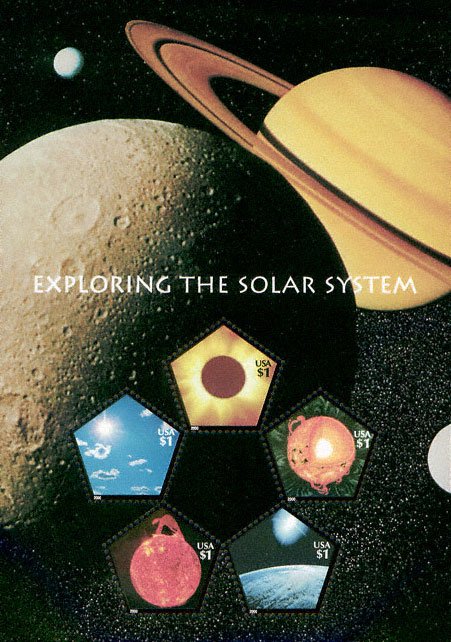
|
| 3409-3413 Press Sheet 7/11/2000 |
Space Achievements and Exploration |
The five souvenir sheets above and this press sheet were
all released at World Stamp Expo 2000, a July, 2000 USPS-sponsored extravaganza in
Anaheim, CA. I attended, and had a good time, partly because there was
no one else there, so I had no competition at the dealer stalls!
None of these items was available from post offices. After their issuance at WSE 2000 they could be obtained from the USPS Philatelic service only. The lower image shows the uncut sheet before the holograms were applied, and with its marginal markings still present! |
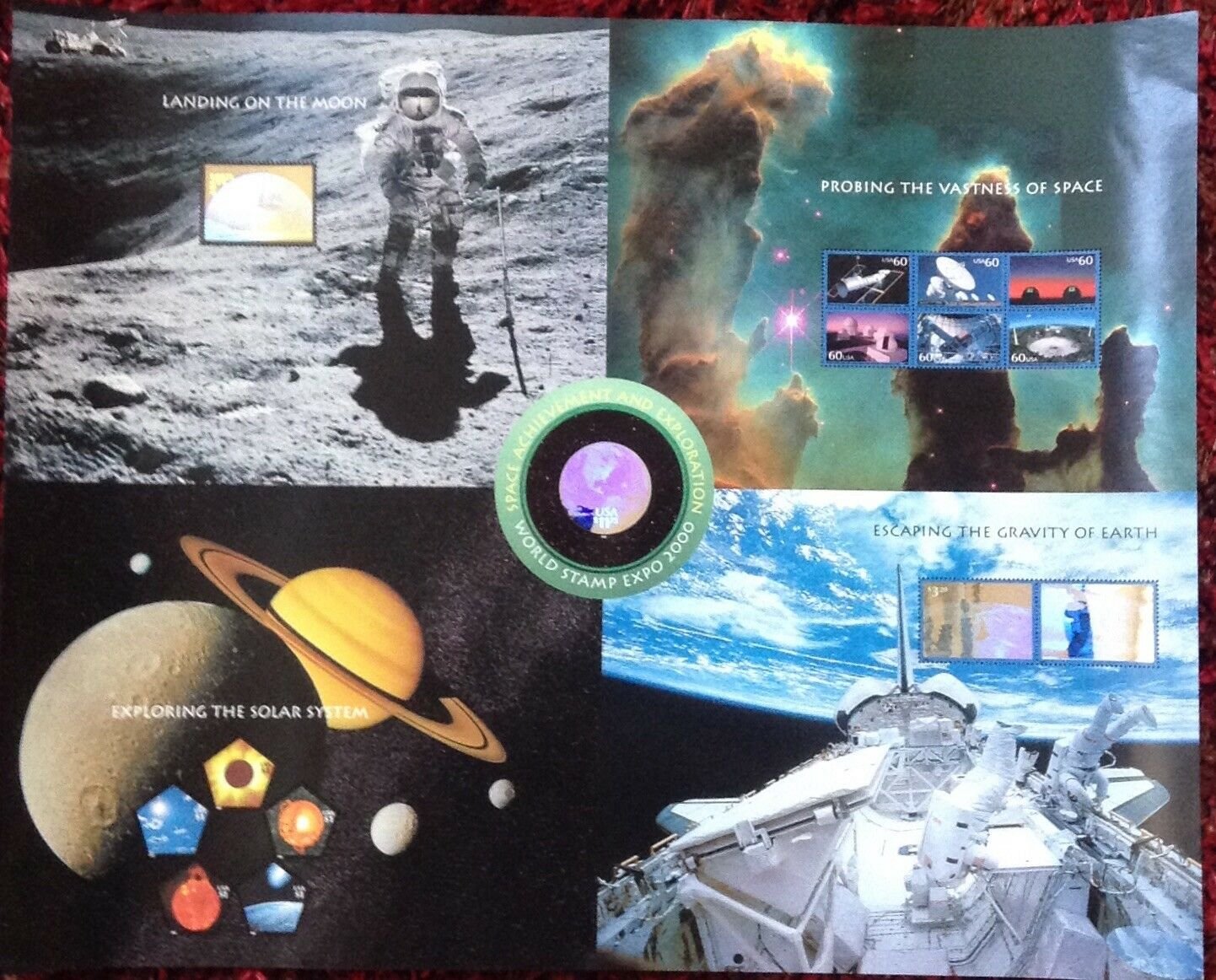
|
| 3414-3417 7/13/2000 33¢ |
Stampin' the Future |
Issued at WSE 2000
Text from top selvage of sheet:
These four stamp designs - chosen from more than 120,000 entries in a 1998 contest for kids 8 to 12 -
depict the winners' views of what our world will be like in the next millennium.
Three of the designs have clear space themes, and the fourth (the heart-shaped earth) could
qualify too.
Artists and titles: |

|
| 4527-4528 5/4/2011 (44¢)
Domestic rate |
Space Firsts -
Project Mercury & MESSENGER Mission |
The stamp on the left honors NASA'a Project Mercury space program, and
Alan Shepard, the first American to
orbit the Earth, on 5/5/1961. It was released one day before the 50th anniversary
of that event.
The stamp on the right commemorates the NASA Messenger mission, which was active when the stamp was released. Launched on 8/8/2004, NASA's Messenger spacecraft reached Mercury via a complex 6.5 year journey, and then orbited Mercury for more than four years, 3/11/2011 to 4/30/2015. Among its accomplishments, the mission determined Mercury's surface composition, revealed its geological history, discovered details about its internal magnetic field, and verified its polar deposits are dominantly water-ice. The mission ended when Messenger ran out of fuel and slammed into Mercury's surface. The Project Mercury stamp depicts Shepard, the Mercury capsule Freedom 7, and the Redstone launching rocket. The MESSENGER Mission stamp depicts the MESSENGER spacecraft in orbit around the planet Mercury. |

|
| 4740 1/28/2013 ($1.10)
International rate |
GLOBAL FOREVER - EARTH |
This was the first International Rate (Global) Forever stamp
issued by the USPS. There have been six more since - all are round.
The image is a composite of multiple NASA images, since the planet is never completely cloud-free! |

|
| 5058 2/22/2016 ($1.20)
International rate |
Moon | Based on a photograph of the moon taken by Beth Swanson of Ft. Lauderdale, FL. |
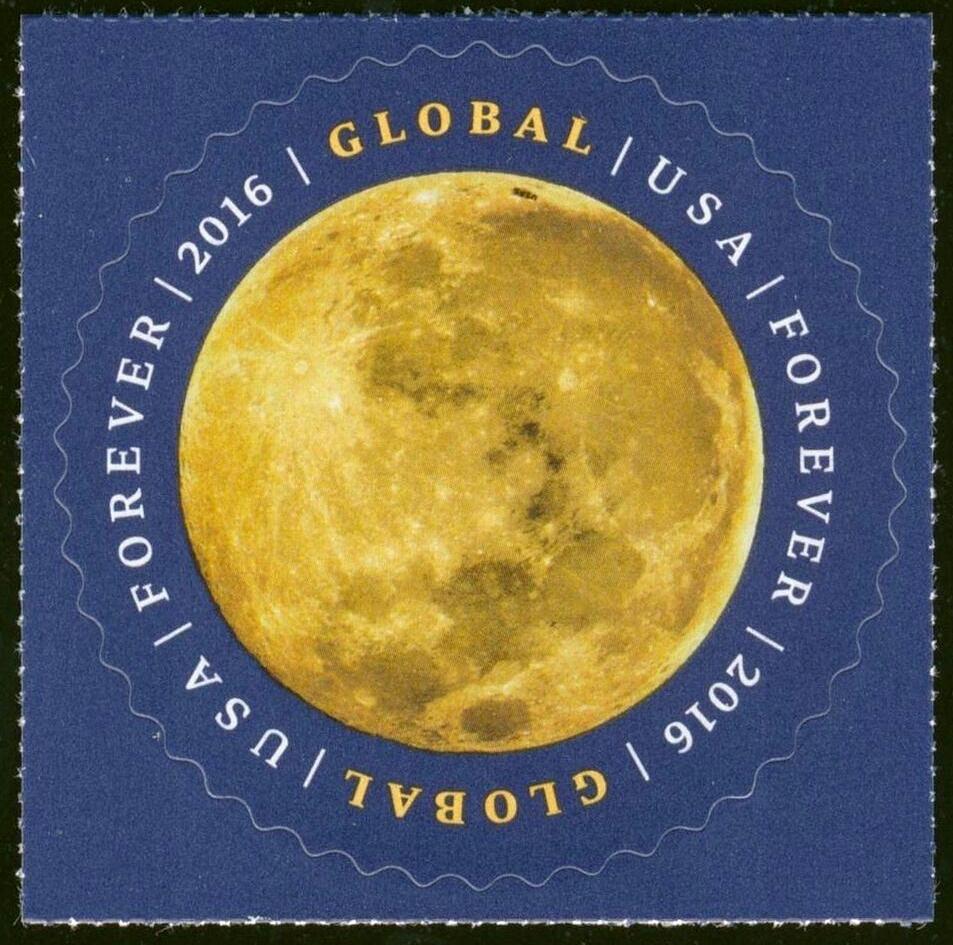
|
| 5069-5076 5/31/2016 (47¢)
Domestic rate |
Views of Our Planets |
From the USPS press release:
With this pane of 16 stamps, the U.S. Postal Service showcases some of the more visually compelling full-disk images of the planets obtained during this era. Some show the planet's "true" color - what we might see with our own eyes if traveling through space. Others use colors to represent and visualize certain features of a planet based on imaging data. Still others use the near-infrared spectrum to show things that cannot be seen by the human eye in visible light. Verso text explains what these images reveal and identifies the spacecrafts and powerful telescopes that helped obtain them. |
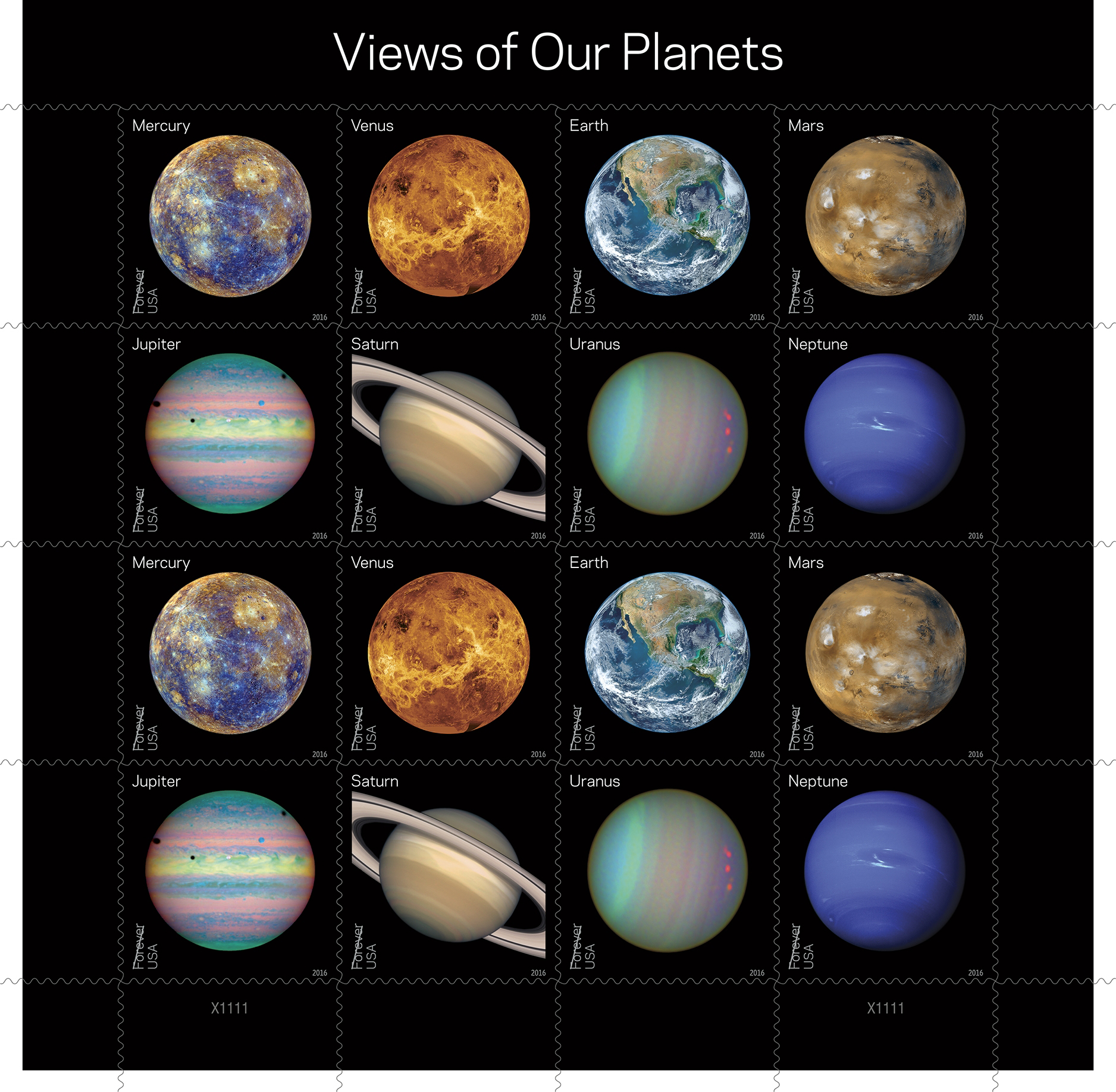
|
| 5077-5078 5/31/2016 (47¢)
Domestic rate |
Pluto Explored/New Horizons Probe |
From the USPS press release:
With this issuance, the U.S. Postal Service recognizes the history-making first reconnaissance of Pluto in 2015 by NASA's New Horizons mission. The Pluto-Explored! souvenir sheet contains two new stamps (each appears twice on the sheet). The first stamp shows an artist's rendering of the New Horizons spacecraft. The second shows the spacecraft's striking image of Pluto taken near closest approach. The view, which is color-enhanced to highlight surface texture and composition, is a composite of four images from New Horizons' Long Range Reconnaissance Imager, combined with color data from the imaging instrument, Ralph. It clearly reveals the now-famous heart-shaped feature (informally called Tombaugh Regio) that measures about 1,000 miles across at its widest point. |

|
| 5211 6/20/2017 (49¢)
Domestic rate |
Total Solar Eclipse |
A total solar eclipse occurred over the Continental US
on August 21, 2017. The USPS joined the frenzy by issuing
these stamps, with a special feature.
Image is heat-sensitive, turns from dark to light, but loses that feature quickly if not kept in special sleeve. Dark image is eclipsed sun, light image is full moon with a solar corona. Is that odd? I guess a picture of the uneclipsed sun would be boring.
From the USPS release notes: |
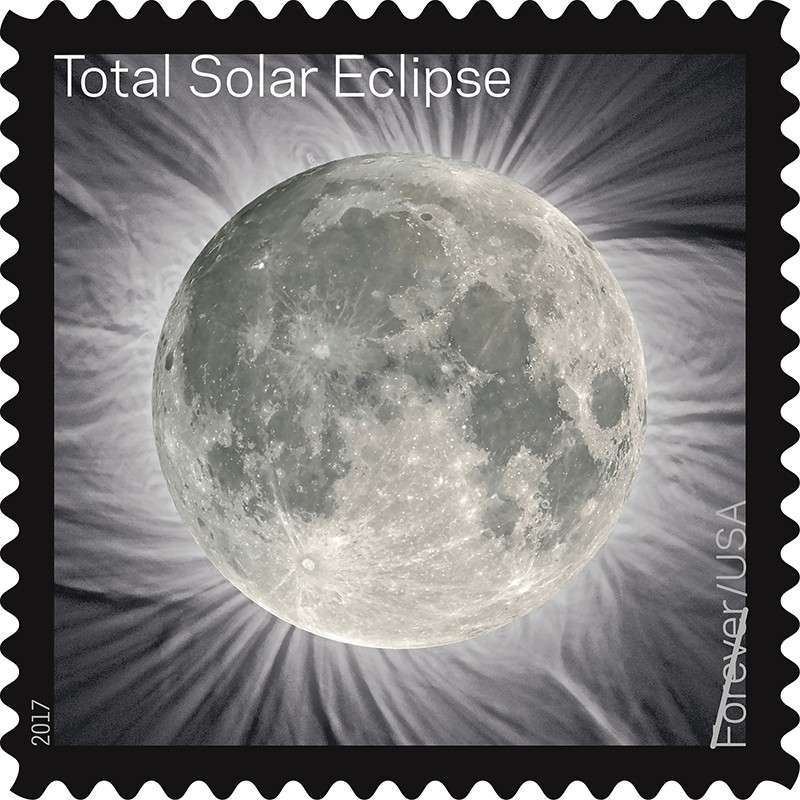
|
| 5276-5279 4/6/2018 (50¢)
Domestic rate |
STEM Education |
These stamps acknowledge the role science,
technology, engineering and mathematics play in keeping America a
global leader in innovation.
Designed to pique the curiosity of the viewer, each stamp features a collage of faces, symbols, drawings and numbers that represent the complexity and interconnectedness of STEM. The Engineering stamp shows a schematic design of the command and service modules of the Apollo spacecraft. |

|
| 5283 5/23/2018 (50¢)
Domestic rate |
Sally Ride | Sally Ride was the first American woman in space, as well as the youngest American astronaut, as she was just 32 years old when she joined the crew of the space shuttle Challenger. Following her career as an astronaut, Ride worked as a physics professor at the University of California, San Diego and as director of the California Space Institute. |
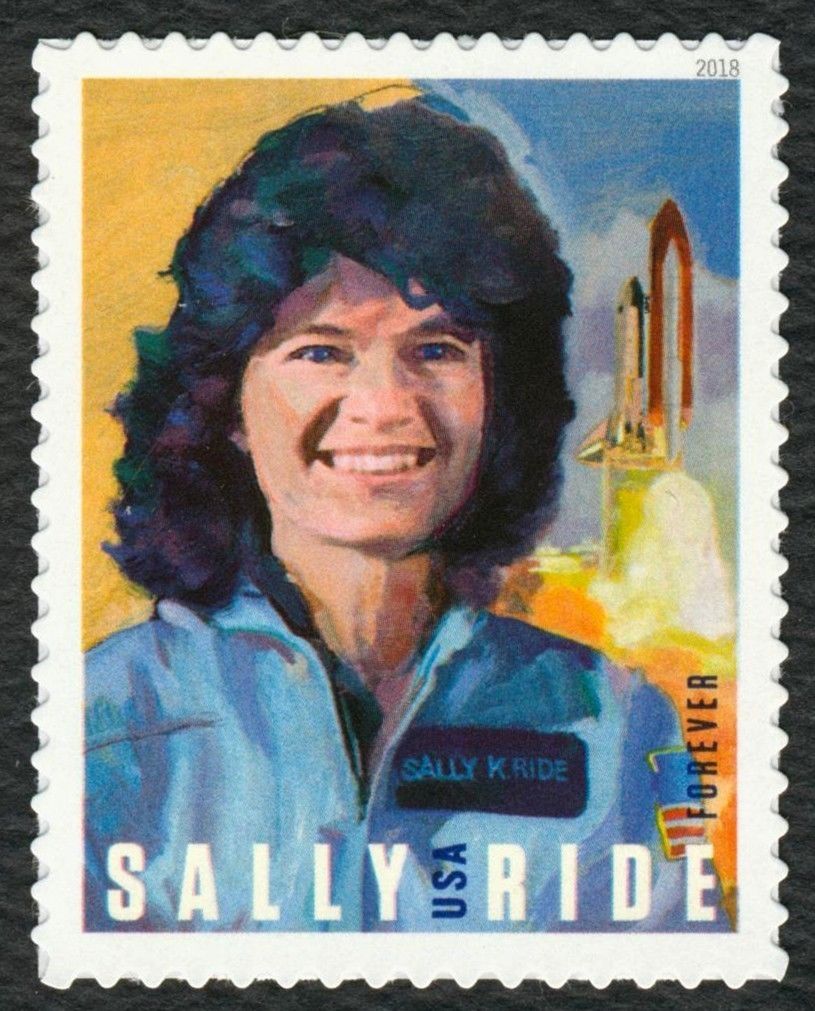
|
| 5399-5400 7/19/2019 (55¢)
Domestic rate |
50th Anniversary of 1st Manned Moon Landing |
FINALLY, here's what inspired me to create this page:
two new stamps being issued on July 19, 2019 (July 20 is a Saturday)
to commemorate the 50th anniversary of the first manned
moon landing.
From the USPS release notes:
On the fiftieth anniversary of this first Moon landing, two stamp designs
commemorate that historic milestone. One stamp features Armstrong's iconic
photograph of Aldrin in his spacesuit on the surface of the Moon. The other
stamp, a photograph of the Moon taken in 2010 by Gregory H. Revera from his
home in Madison, Alabama, shows the landing site of the lunar module, Eagle, in
the Sea of Tranquility. The site is indicated on the stamp by a dot.
7/22/2109 - I like these stamps much better in person than in pictures.
At right are two images of the full pane of 24, the top one a scan enhanced to show off the details,
and the bottom a photo that attempts to show how they really look - and fails.
The "white" on Aldrin's suit is actually silver foil, applied in some technique
I can't figure out. Maybe it's just silver ink. I'll have to ask a friend. But it really brings
the images to life! You have to see these "live" to appreciate them.
8/19/19 - At last! Linn's revealed today how the shimmery effect on these
stamps was achieved:
United States Postal Service officials have revealed the secret behind the silvery shimmer on its new Moon Landing Anniversary forever stamps. |

Original design - Yellow dot |
TOP
All text and images are the property of the author. Any errors are his.
If
you have better or additional information about anything shown or discussed here,
please email the author.
All Letter images Copyright © 1997, 2000, SF chapter of AIGA
All text Copyright ©, William M. Senkus
Send feedback to the author: CLICK HERE
Created -- 07/12/2019
Revised -- 02/20/2021

